#my character in particular spent a while exploring his home region
Text
we just finished playing through Curse of Strahd today; what a wild, long, and nice ride
#nane liveblogs life#pnp stuff#our paladin died a couple of sessions ago but he was definitely not forgotten in the epilogue#was very melancholic#someone devoted a temple to his name and made his sword a relic#my character in particular spent a while exploring his home region#and then eventually when she couldn't find any family who could still remember him#buried his dagger someplace nice at the Sword Coast under a little gravestone
2 notes
·
View notes
Text
Running Your Best Convention One-Shot Part 2: Scenarios

At the 2021 Origins Game Fair, I experienced one of the best convention one-shot RPG sessions I’d ever played in—as well as the worst—back to back. This gave me a unique opportunity to compare and contrast what went well in the first session and what went awry in the second, especially in light of my experience as a tabletop RPG professional responsible for developing one-shots as well as demoing RPGs for convention play. Over the last ten years, I’ve run open and VIP tables at large flagship conventions like GenCon and Origins, regional cons such as AcadeCon and Con of the North, and local mini-cons on college campuses and at my own home. Over the years, I’ve also made my fair share of mistakes that I hope you can learn from.
Although there are many aspects to consider when planning and running an RPG one-shot at a convention, focusing on three elements of the session can give you a solid foundation and yield the best payoff per hour of prep spent. These three essential ingredients are: 1) exciting and accessible pre-generated character sheets, 2) a scenario that is optimized for one-off play, and 3) excellent player management at the table. In this second part of three, let’s take a deep dive into the next ingredient: the scenario.
The Purpose of One-Shot Scenarios
A one-shot is a roleplaying game session designed to offer an engaging play experience and tell a satisfying story within a single sitting. In most convention settings, a four-hour block of time is set aside for the game, but some “epic” sessions might last for six hours, while demos are typically designed to run for just one or two hours. With your regular gaming group, you might have a whole evening to play, without a hard cutoff point other than people’s energy levels.
I consider the play experience to be composed of two things: the GM’s primary motivation for running the one-shot, and what the players are expecting from the scenario. Are you trying to give players a taste of a game’s rules system? Are you looking to bring a set piece encounter to life with elaborate maps, minis, and terrain? Are you offering a chance to play a particular type of character that’s unusual, specialized, or high-powered? Are you trying to introduce or explore a particular setting, time period, or franchise? Or are you trying to entertain with an especially clever premise or mashup of different media properties? (“My Little Warhammer: Friendship is 40k,” I’m looking at you.) If you know what you’re trying to achieve, that can help you focus and prioritize your efforts.
Telling a satisfying story in a single sitting can be challenging, as it’s easy to try to cram too much plot or too many characters into the span of time available. There’s really only time to explore one main objective, a few obstacles, and a set of simplistic stakes. It might be helpful to treat your one-shot as if it were a single twenty-minute episode of a TV show—I often see folks try to cover the same amount of ground as a three-hou epic fantasy film, which just isn’t feasible. Here’s the basic formula I use when crafting scenarios:
When [a disruptive event happens], will a group of [adjective] [collective noun] be able to [adverb] [verb] the [noun] (to/from/at/in [noun]) before the [villain] [villain’s objective]?
And here’s that formula applied to a few different one-shots I’ve developed or written:
When a bounty hunter betrays a brutal crime syndicate, will a motley crew of scum and villains be able to capture or kill him before they become his next target? (“Under a Black Sun” for Star Wars: Edge of the Empire)
When a long-lost heir threatens to interrupt a politically crucial marriage, will a group of young samurai must choose see the match through, or call it off in the name of love? (“Wedding at Kyotei Castle” for Legend of the Five Rings Roleplaying)
After a rival underhive gang kidnaps their leader, will a group of Escher gangers be able to rescue their champion and get revenge before one of them reveals themselves to be a murder-cyborg? (“Fall of the House of Escher” for Dark Heresy 2nd Edition, unpublished con scenario)
Time Constraints and Pacing
In my opinion, the primary consideration for a one-shot is the time constraint. If the game runs longer than its allotted time, you won’t have a chance to pick up where you left off the following week or session—you’ll have to rush to the ending or worse, not offer a resolution at all.
My rule of thumb is to plan on roughly one encounter, dungeon room, or scene per hour (from here on, I’ll use the term “encounter” to refer to any of these discrete RPG session elements). For a four-hour one-shot, I try to stick to this schedule:
Introductions (30 minutes): Players choose characters and unpack dice/dice trays, GM introduces rules and setting, answers questions. I try to make sure that the PCs understand their goal going into the first encounter before we hit the 30 minute mark.
Encounter 1 (45 minutes): In pursuit of their goal, the PCs confront an obstacle that might be solved with combat, social interaction, exploration, or investigation.
Encounter 2 (45 minutes): The PCs encounter their next obstacle, one more challenging or with higher stakes than the first. There might be a major twist or reveal at the end of this encounter.
Break (15 minutes): Bio break—let people use the bathroom, get a drink/snack, check their phone, or simply stretch their legs.
Encounter 3 (45 minutes): The PCs encounter yet another obstacle, and they might glimpse opposing sides of the dilemma or fully grasp the stakes.
Final Encounter (1 hour): This is the climactic encounter in which the PCs make a decisive choice and/or face their hardest challenge yet.
I typically have an extra encounter or two in my back pocket in case the PCs breeze through one or more or the earlier encounters faster than anticipated, but these encounters can be left out without hurting the players’ enjoyment or understanding of the overall plot.
Pacing refers to the rate of movement or progress. In RPG terms, pacing refers to how quickly the PCs move from encounter to encounter or experience the story. Bad pacing can make for an unenjoyable game—players might grow bored if they are progressing through encounters too slowly, or they could feel dissatisfied or confused if they are moving through encounters too quickly. You can also affect pacing through variety: a one-shot that’s solely combat, investigation, or social encounters can blur together or feel repetitive, so include a mix of the different types of encounters that feature in the game’s rules, as well as emotional highs and lows (juxtaposing comedy with horror, for example). But take care when stringing vastly different kinds of encounters together. Not having appropriate transitions between encounters can feel jarring, so if there’s a little bit of travel or if time passes, make sure that’s communicated to the players. Give the players time to react to big events and talk among themselves, and once the conversation has run its course, that’s your cue to move on to the next encounter.
It takes some practice and experience to get pacing right, but you can look to your players for signs that the pacing is off—are they tuning out and checking their phones? Chatting among themselves trying to figure out what’s going on? Remember, you can always “fast forward” using narration to get to the next bit of action or excitement (but beware taking agency away from the PCs—you shouldn’t skip over any major decisions that could affect the story). From a logistical perspective, if one encounter runs long, you’ll need to shorten one of the subsequent encounters. If the encounters go by too quickly, however, the session will end early, which usually isn’t too big a deal at big conventions where there’s plenty to do and see (and eat), but it can be a bummer when players paid by the hour for an event.
Agency and Choice
To me, great one-shots are those with multiple possible endings, such that I can run it for different groups of players and have wildly different outcomes. This isn’t always feasible in organized play circumstances, where a shared experience is part of the point. When considering alternative resolutions, you might ask: Do the PCs pursue their original objective, or do they turn on the person who gave them the mission? Do the PCs side with one NPC or another in a dispute? Do the PCs achieve their goal by talking it out, using violence, or employing magic to solve their problems?
Agency is “the capacity, condition, or state of acting or of exerting power”—in games, that translates to the idea that the PCs can affect the game or the game world, whether for good or ill. Unlike most novels or TV shows, games are an interactive medium, so giving players some choices that matter will help them feel invested in the story.
The worst one-shots are those where the players don’t have agency and their actions don’t matter—the NPCs are too powerful or the PCs too weak to make a difference, or the PCs’ efforts turn out to be futile. One-shots that feature many long, scripted narratives in which the GM is basically telling the story without the players’ input can be indicative of one-shots with little player agency. In these moments, there’s no opportunity for the PCs to interject or act unless they—gasp—interrupt the GM, which many players will not feel comfortable doing. Cut scenes have become less popular in video games over time, and many players skip them altogether. Avoid cramming your one-shot full of cut scenes—think about where in your story would benefit the most from one deep, evocative description, and use it there.
When creating dilemmas and offering choices, one of the biggest considerations are stakes: what will or will not happen if the PCs fail, as well as what will or will not happen if they succeed? Choices should have consequences: rewards or punishments, treasure or injury, fame or infamy. Decisions don’t always have to be an either/or choice. They might be a question of methodology (how the PCs achieve the outcome), or a matter of degree. What matters is giving your players a say in how the story unfolds. Designing a scenario that takes player agency into account and offers meaningful choices and multiple resolutions are much more likely to engage players emotionally and make your one-shot a memorable one.
Let the Pre-Gens Shine
If you followed my advice and carefully crafted your pre-generated characters to suit the one-shot medium, those can be your guiding stars for designing your scenario. Try to match up the skills and capabilities of the PCs to the challenges offered, so that you have at least one sneaky character if the mission calls for stealth, one bruiser character for combat, one investigative character for discovering clues and solving mysteries, and so on. If the PCs come from different backgrounds in the world, try to make those backgrounds matter to the dilemma at hand or the choices offered. If your game features scheming and backstabbing among the PCs, those backgrounds can potentially put them at odds, as can conflicting motivations or agendas.
Once you’ve figured out what your four-plus encounters will be, return to your pre-gens and check whether they’re capable of tackling those challenges as a group. Ensure every PC will be able to contribute something to every encounter, and let them bring something extra to one encounter that can be their moment to shine.
Critical Hits and Fails
One spot your one-shot can crit fail is right at the beginning—if the players don’t know what they’re supposed to doing, they’ll flail around until they find something concrete to pursue, raising the risk that they’ll try to do something or go somewhere you haven’t prepared for. Create a strong and simple hook for why the player characters are involved and what they’re hoping to achieve—one that doesn’t require a ton of explanation or background knowledge. Such-and-such faction needs you to acquire the MacGuffin, rescue the princess, or eliminate the target (and in this case, yours not to reason why, yours but to do or die). You want to plunder the dungeon or raid the cultists’ lair for loot and glory. You need to get off this island/space station/planet because if you don’t, you’re all dead. If you need to provide a ton of context for players to understand the scenario, simplify the plot down to its essence or save that particular scenario for a mini-campaign, where you’ll have more time to get into the weeds.
Another area where your one-shot can go awry is if you’re trying to make the game system do something it wasn’t meant to do, or emphasize a part of the game rules that isn’t well supported. If chases are really challenging to arbitrate in that game, either simplify the chase rules (at the worst, narrating them instead of trying to mechanize them) or avoid chases altogether. If you want to include psionics in a game where psionics are rare and work totally differently from regular magic, either make sure players know that up front and study the rules ahead of time, or avoid psionics in the first place. More egregious examples would be using a game that’s mostly a combat simulation to run intricate social intrigues. If you find yourself homebrewing rules for your one-shot, ask whether you’re making the game more accessible or more complicated. Players typically need some reminding how the normal game system works, much less how something they’ve never encountered before should function.
One place where your scenario can roll a critical success is with physical props. If you prepare relevant handouts, print off maps or terrain, or provide standees or miniatures, you’re adding an extra tactile experience to your game, which can provide novelty and engagement. Handouts could be representations such as illustrations of certain rooms or NPCs, in-universe artifacts such as mission briefings or newspaper clippings, or even small trinkets from your local thrift store to represent important artifacts. If the MacGuffin is a special necklace that needs protecting, how cool would it be to have a physical representation of that necklace on hand for one of the players to wear? If the PCs will be attending a masquerade party, you can enhance the immersion by providing some cheap masks for them to wear while they roleplay. (If it’s something a little silly, dive into it with gusto, and your players will likely follow.) I always think of the enormous “Treasure Island” diorama that gets set up at Con of the North every year, complete with minis and pirate ship and resin water, which looks like an absolute delight to play on and is not something I get to do at home. And some of the clubs take over entire rooms and decorate their space to suit their games, creating an immersive and unforgettable experience.
A few caveats: Regarding text-based handouts, just make sure they’re brief and to the point (journals with multiple entries or a collection of letters are often too much for a one-shot). If hand-outs are going to need to be deciphered, figure in plenty of time for the PCs to work out the solution and discuss the implications among themselves. Along those lines, be sure to give yourself extra time to set up or tear down any maps or minis or terrain, and consider how you’ll transport them to the convention (including through airport security) and how you’ll store those items between sessions, if you’re running the one-shot multiple times.
Even if you aren’t writing a one-shot scenario from scratch, you can use these suggestions to improve how you run published adventures. If there are too many encounters, figure out what you can change to cut the scenario down to fit in the allotted time slot. Add choice points or dilemmas if the module is overly linear. Adjust the pre-gens to be more usable, and figure out ways you can make those lengthy read-aloud boxes part of the action.
Stay tuned for the third and final part of this series on managing players at the table! You can be notified of when they’re posted by subscribing to my email newsletter here.
#roleplaying games#dm tips#gm tips#rpgblr#writing rpgs#gamemastering#game master#dungeon master#dungeons and dragons#rpg
1 note
·
View note
Text
There Was Janus
Pairing: Logince, Past Roceit
Rating: PG
Word Count: 1,239 words
Summary: Roman and Logan get to know each other after working in the same touring production for the last month, when Logan asks how Roman got into acting.
Other Notes: I never write Logince. I was reminded of this song and got Logince vibes. I highkey wanna make this a series but I got so many other series right now so I'll see how this does.This is based off of the song There Was John from Tootsie (btw Tootsie ain't problematic and I will die on this hill)
AO3
Logan had been touring with the company for the last month and a half as a stage manager. He’d gotten to know most of his coworkers quite well, content to spend time in each new city exploring between shows and getting lunches with the cast and crew. One particular lead, however, he had waited to get to know better on purpose. See, Logan had developed somewhat of a fleeting crush on Roman over the last month and he had feared that speaking with him would either amplify his feeling or kill them entirely. And honestly, he wasn’t sure which of those possibilities were worse. Having crushes in general were cumbersome to Logan. He preferred the ease of friendships and acquaintances. But something in him wanted to see where it went. After all, although crushes were annoying, he did not enjoy the loneliness he often felt in his hotel room after each show was concluded or the times off when he was able to return to his apartment.
It was the end of a matinee, and Logan decided after everyone had left that it would be a good idea to rest at the hotel before coming back for the evening show. He was just about to step out through the stage door before a voice called out behind him. “Hey, Logan!” He whipped his head around to see Roman, the brightest smile on his face as he approached him. “You heading back to the hotel?”
“Uh- yes. I am. May I ask why?”
Roman pulled his messenger bag over his head. “I’m going that way too. I figured we could hang out, maybe get some lunch? Unless you’re too tired or something.”
Logan blanked for a moment, the fact that he crush was asking to do something with him short circuiting his brain. Eventually, he was able to answer, although his voice was a bit shaky. “No, that sounds perfect. To be honest, I had almost completely forgotten to get lunch.”
“…How? You’re literally the one making sure all of us have had a good nutritional meal between shows. Isn’t that a little…uh…” he trailed off, looking for the right word until Logan helped him out.
“Hypocritical?”
“Yep! That’s it. You’re really smart.”
Logan opened his mouth, but no sound came out. Roman laughed and pat his shoulder as he made his way up to the stage door. “Come on, I found this great place yesterday down the street.”
They ended up getting takeout and walking back to the hotel, and by the time they’d made it to Logan’s room and eaten, the two had warmed up considerably to each other. Logan had told him about how he’d wound up as a stage manager, how he’d worked in a few productions in college and promptly changed majors, and how he lived in his apartment in New York City with two cats who lived with his mother when he was working tours. And Roman listened carefully, seeming to hang on to each word that Logan said. He still looked tired from the show, but he’d grabbed a coffee from the restaurant so that was keeping him alert for the conversation.
“What about you? How’d you get into acting?” Logan asked him, stealing a glance at his watch to see the two still had about twenty minutes before they needed to start heading back to the theater.
Roman leaned back on the bed, looking to the other on the other side with a reminiscent smile. “I decided to major in theatre in high school, but by the time I was in my senior year of college, I was starting to have doubts about everything. I didn’t feel like a great actor and everyone else in my classes were better than me. But in our spring production, there was a guy in the audience. Janus.” He paused for a second to shift his body, trying to get more comfortable to get further into the story.
“He came backstage after the show. His friend was one of the ensemble members and brought him back to meet everyone. We hit it off immediately and he told me he’d connected most with my character because I played it so well…we dated for a year before moving in together. Not too long after I was offered a slot in the regional company. I was so excited to get away from a job I hated. I spent all of my time in rehearsals and performances. Janus came to every show, happy to be there to support me. He never complained. We’d go home and spend a few hours together before I had to get up for rehearsals yet again. It took everything out of me, but I loved it.”
Logan was listened intently to the story, entranced by the way Roman told his life like it was a book. “I started tours a year or so later. Went on the road for month on end, spent an entire summer on the west coast. Janus tried to call every night, and that was the routine for a while. Until one night, he called me and laid everything out. Told me he wanted kids and a married life. That’s when everything clicked for me. This was my life. I’d made my choice long before, but never told him…and when I got home, can you guess?”
“…Yeah,” he replied quietly, feeling deeply sorry for what he figure happened next.
Roman nodded once and continued. “He was gone. All his stuff, his clothes, gone. I was alone in our house and I almost broke down. But thinking back on it, I’d do it all the same.” He grabbed a water bottle and took a long drink to get rid of his dry throat. “He lives in Portland now, with his husband and a kid. But here I am, in yet another tour just how I like it. So, that’s how I got into acting.”
Logan didn’t know what to say. It was a whirlwind of information, but he had wanted to know more about Roman, and he got it. He just hadn’t expected to know about something this deep. “You’re amazing,” he blurted, mortified by the phrase the second it left his mouth.
The blare of Roman’s alarm on his phone prevented him from answering. “That’s my ten minute warning. We should start heading to the theater.” Logan just nodded in response and silently followed him out of the room and to the elevator. “So, if you’re not ready to pass out from exhaustion after the show tonight, could I take you out to dinner?” he asked as the elevator doors closed.
The stage manager froze in place, barely hesitating before quickly responding, “Yes-” the way his voice cracked had him clearing his throat and repeating himself. “Yes. I’d like that.”
“Great,” Roman said with a grin, jumping out of the elevator when it reached the ground floor. “I’ll make sure not to annoy you during intermission, then.”
Logan spent the entirety of the show more jittery than he’d ever been, both excited and terrified for the proposed date that got closer and closer with every applause from the audience. But oddly enough, there was that same little voice asking him to hang on to his crush that reminded him everything would be okay.
And looking back years later, he was so grateful to have listened to that voice.
43 notes
·
View notes
Text
Demons Of The Punjab - Doctor Who blog
(SPOILER WARNING: The following is an in-depth critical analysis. If you haven’t seen this episode yet, you may want to before reading this review)
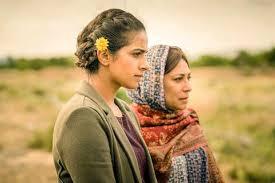
Let us now look at our first non-Chibnall episode this series. Demons Of The Punjab, written by Vinay Patel.
Curious about her grandmother’s past, Yasmin persuades the Doctor to take them to India in 1947 only to discover that the man her grandmother is marrying isn’t her grandfather, but a Hindu man named Prem. What follows is quite possibly the most well written and emotionally charged Who historical story I think I’ve ever seen.
Honestly this comes as something of a relief. I confess when the giant alien bats showed up, screeching and teleporting all over the place like something out of a tacky horror film, I was worried. Chris Chibnall and Malorie Blackman showed remarkable restraint with their episode Rosa, focusing solely on Rosa Parks and the oppressive society she was forced to endure without letting the sci-fi elements intrude or distract from the narrative. With this in mind, an amateur production of ‘Attack of the Killer Bat People’ trouncing all over partitioned India doesn’t exactly seem like a good follow up to me. Thankfully they don’t go that route. Turns out that the Thijarians (not the Vaginas, as I first misheard them) are just a massive red herring. They’re not alien invaders. They’re just travelling psychopomps comforting the dead. Presumably they’re the basis for the numerous death deities that have appeared throughout many cultures and civilisations. It’s a nice idea. Granted the episode would have worked just as well without them, but it’s still a good twist on the monster of the week format nonetheless.
Patel quite rightly focuses on the characters and historical setting. Demons Of The Punjab is refreshing in more ways than one. It’s a historical, but it’s not set in Britain or America. Some people (let’s call them idiots) may complain that the show is getting ‘too PC’, but I for one am quite interested in the history of India. It’s about time we delved into the past of another country and another culture. New Who has spent so much time in Victorian London in recent years, I’m surprised the Doctor doesn’t just rent a holiday home there. It’s also nice to have an episode that isn’t afraid to point out that the British Empire was... well... a bit of a bastard, to put it mildly. The Moffat era in particular was very much guilty of romanticising British history (the most notable example being Winston Churchill, presented as a cuddly leader and the Doctor’s bezzie mate when in reality he was a colossal racist and arguably the very epitome of British imperialism in the early twentieth century). Patriots and anglophiles can’t help but think of Britain in positive terms, seeing the British Empire as some kind of noble ideal. The truth of the matter is the British Empire wasn’t some Utopian peace keeping force uniting the world. It was a bunch of white colonialists taking other people’s land and resources and not giving a tally-ho fuck what the ‘alien races’ thought.
The partition of India is quite possibly one of the most petty and irresponsible things we as a country have ever done. Crudely dividing the country into regions before picking up their ball and going home, leaving the native Indians to sort it out for themselves. What angers me is that I was never actually taught this in school. I learned about the partition of India years later through fucking Wikipedia. And you’d think this is something we ought to know. Like the Atlantic slave trade, this isn’t ancient history. This happened relatively recently and the after effects are still being felt today.
So not only am I’m glad we’ve got an episode like this, I’m also glad that Patel chooses to explore the partition of India in a very intelligent and respectful way. Like with previous episodes, Demons Of The Punjab is very intimate and small scale. It’s not about the Doctor combating a massive threat. It’s about how a massive threat affects the lives of this one family.
Demons Of The Punjab has a stellar cast to play Yasmin’s extended family. Amita Suman does an excellent job as the younger version of Yasmin’s grandmother Umbreen. Something this series has been really good at for the most part is finding that humanity at the core of the stories. It’s not about the aliens. It’s about the people. Demons is not about the space bats. It’s about this young woman struggling to compromise between committing to her Hindu fiance and staying faithful to her Muslim faith in the wake of rising political and societal tension, and Suman portrays this perfectly. It’s an incredibly powerful and moving performance and it’s her character you feel for the most.
Then there’s Shane Zaza as Prem, quite possibly the nicest guy in the fucking world and definitely didn’t deserve his final fate. He’s appalled by the rioting and infighting, saying how this wasn’t what he fought for in the war. Despite being confused and scared by the ‘demons’, he still accompanies the Doctor and Ryan and protects them from harm. But most importantly, he clearly loves Umbreen dearly, preparing to share and adapt his beliefs to hers and vice versa. Throughout the episode, Prem and Umbreen’s relationship is presented as the ideal. A love for the ages. How the world should be, transcending belief systems and cultural barriers. This could have become quite sickly in the wrong hands, bu thankfully the episode never over-eggs the pudding. We like this couple and we like Prem, which is what makes his death at the end one of the most heartbreaking in all of New Who and the fact that this comes at the hands of his own brother makes it all the more tragic.
Hamza Jeetoa’s performance as Manish was exceptional. From the start you know there’s something not quite right with him as he seems to buy into the India/Pakistan border quite enthusiastically, but I assumed (perhaps in my naivety) that the Doctor would persuade him to accept his new sister in law Umbreen over the course of the story. Of course that’s not the case. Like I said, the aliens are the red herring. The real villain is Manish. Except... it’s not. While Prem was out fighting for the Brits, a disillusioned and confused Manish was left alone, leaving him a prime target for radicalisation. So as disgusting and horrifying as his actions are, it’s hard to truly hate him because he’s not a bad person. You do see occasional glimpses of brotherly affection between him and Prem, a brief window into their relationship before the partition, and it’s this that humanises him and makes him an effective antagonist. Yes he’s killed people, yes he killed his own brother, yes his views are downright poisonous, but he is in many ways just another victim of this turbulent time. He’s a cautionary tale about the dangers of rigid belief systems and how easy it is to indoctrinate and radicalise the young and disenfranchised. Jeetoa does a great job selling this character without tipping over into panto. He’s not some rabid bigot foaming at the mouth. He’s a confused young man who has willingly bought into this anti-Islamic dogma because of his own frustrations toward the British, He feels like an actual person. It’s this that makes the ending truly shocking.
I don’t think there’s any need to talk about the main cast. They are predictably good. Jodie Whittaker continues to blow me away as the Doctor. Her eulogy at the wedding, her excitement and enthusiasm when celebrating the night before with Yaz and Umbreen, and her sorrow and disgust when Manish shoots Prem are all memorable moments showing Whittaker’s range as an actor. Graham and Ryan don’t have as much to do this episode, although they do still have their moments (the scene where Graham hugged Prem and told him what a good man he was made me cry. God, Bradley Walsh can act!). This really is Yasmin’s episode and it’s about time too. My one complaint I’ve had throughout this series so far has been that Yaz has felt largely superfluous. She’s not a bad character by any means. It’s a problem common with many of the ensemble casts Doctor Who has had over the years. There’s always at least one cast member reduced to being the spare part. So it was great to see Yaz finally get a chance in the spotlight and Mandip Gill rises to the occasion as she portrays her character’s internal conflict. Obviously she doesn’t want Prem to die. He’s a nice guy and her grandmother clearly loves him, but he’s not her grandfather. In order for Yaz to exist in the future, Prem has to die. I love episodes where the Doctor and his companions can’t interfere as they often serve as great moral dilemmas as well as the means of exploring internal strife. Watching Prem die, knowing she can’t change it for risk of damaging her own timeline, is painful and gut-wrenching, and Gill gives her best performance to date.
Demons Of The Punjab I think is my favourite episode so far this series because it shows just how flexible the Doctor Who format is and what kind of stories you can tell. This is a very human story that packs a massive dramatic punch and has great relevance to today. As I said, the effects of the partition of India are still being felt today and the radicalisation of young people is something we’ve sadly become all too familiar with (see ISIS and the alt-right). It’s what makes this episode’s central theme, to love and respect everyone regardless of cultural differences, all the more poignant. If Demons Of The Punjab teaches us anything, it’s that we could use a lot more Prems in the world right now.
#demons of the punjab#vinay patel#doctor who#thirteenth doctor#jodie whittaker#graham o'brien#bradley walsh#yasmin khan#mandip gill#ryan sinclair#tosin cole#chris chibnall#bbc#review#spoilers
51 notes
·
View notes
Photo

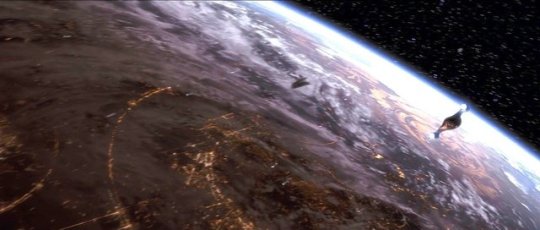
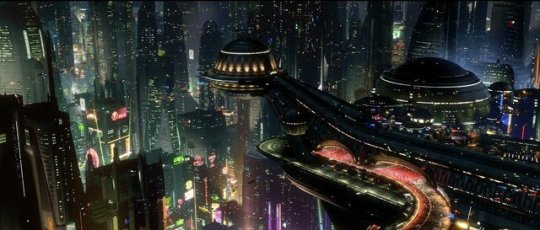


→ STAR WARS: CORUSCANT
→ WHY AND HOW I’M DOING THIS:
Coruscant is my favorite Star Wars planet! It’s the home of the Galactic Senate, it’s the home of the Jedi Temple, it’s later home of the Empire, it’s where much of the action is! My favorite characters spent most of their lives on this city-planet and it’s fascinatingly huge and I desperately want to know more about how it works and so this is my best effort to collate as much info as I could reasonably find. While a lot (if not most) of what will be here has been swept into Legends, which is not my favorite place to go for worldbuilding if I can help it, there’s not much left of this planet if we don’t. But a general rule of thumb is: If it comes with a cap from TCW or the movies, it’s probably canon. If it’s from a reference book or SW Insider (unless otherwise noted), then it’s Legends.
There’s going to be a lot of stuff I’m missing, but I tried to include only things that I could verify from my own sources (Wookieepedia is amazing! but sometimes it doesn’t quote as much as I’d like or show the best angles or sometimes doesn’t give full context) and that are reasonably still workable with the Immovable Objects Of Star Wars History.
→ OVERVIEW:
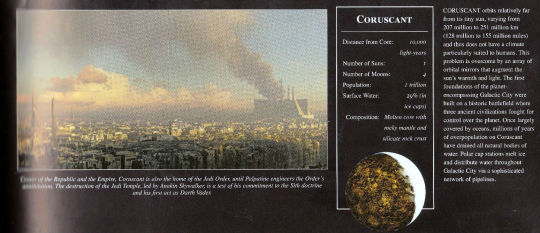
(Larger version here. Star Wars Atlas (2009) profile here.)
PROFILE: 368 days in a year, 24 standard hours, population 1 trillion, species mix is 78% humans + 22% aliens, major export is culture, major import is food/medicine
→ FURTHER OVERVIEW NOTES:
- Coruscant orbits relatively far from its tiny sun [....] and thus does not have a climate particuarly suited to humans. This problem is overcome by an array of orbital mirrors that augment the sun's warmth and light. (from Star Wars: Complete Locations)
- Wookieepedia’s overview is pretty great, so I’m going to quote it, then dig up the references if I can!
Located in the Coruscant subsector of the Corusca sector within the Core Worlds region, Coruscant was a planet covered in a dense ecumenopolis. 12,240 kilometers in diameter, Coruscant orbited relatively far from its small sun, varying from 207 to 251 million kilometers, and thus did not have a climate that suited any one particular species (although this inconvenience was rectified by technological means and the vast heat generated by the multi-level cityscape). There were 24 hours in a Coruscant day, and 365 days in a Coruscant year. Owing to its importance in galactic history, the galaxy used a dating system standardized on Coruscant and the planet's galactic coordinates were 0-0-0 despite it not being located in the exact geographical center of the galaxy. From space, Coruscant's luminosity was slightly dimmed by the planet's hazy cloud cover. The planet's weather patterns were affected by the troposphere-piercing buildings that covered the planet's surface. Inside the tallest buildings, enormous differences of temperature and air pressure from top to bottom produced unusual and unpredictable microclimates. As such, Coruscant had its own weather control system. Thousands of years of development destroyed the planet's ancient mountains and seas. As such, Monument Plaza housed the top of Coruscant's last remaining mountain peak.
MORE OVERVIEW/HISTORY:
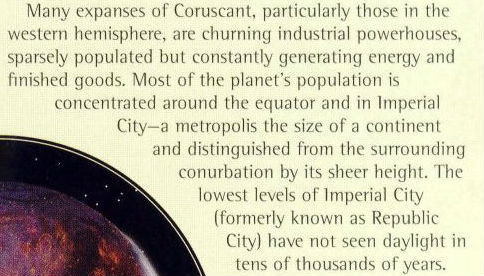
(From the RPG guide Coruscant and the Core Worlds. More here.) Especially interesting of note is that most people are centered around the equator, the Western half of the planet is less populated but that’s where they generate their energy, and the main city is the size of a continent.

(From Star Wars Complete Locations. Larger image here.)
”In the top levels of Galactic City, the richest citizens breathe their preferred choice of gas in high-grade, purified form. Their buildings are routinely scanned for impurities, and problems are dealt with by teams of quality-control droids. In the dirty underworld of tunnels and corridors at the base of the massive buildings, inhabitants struggle to exist on barely breathable combinations of waste gasses. Many regular visistors to Coruscant choose to bring their own air supply to last the length of their stay.”
I would take this with a major grain of salt as we never really see it playing out in the movies or the TV shows, despite the time we spend in some of the highest buildings on Coruscant.

(Larger version here.)
This isn’t much to go on besides a few names of places, but it does show the way Coruscant is built up and up and up, how some buildings get buried along the way and just how crowded everything is.

(Larger version here.)
A map of the chase scene from Attack of the Clones, when Obi-Wan and Anakin are trying to hunt down Zam Wessel. While there’s not a ton of worldbuilding here, it does show the density of the buildings and at least gives you an idea of where the Skysitter restaurant [see below] is, where several hotel chains are (Novaplex, the Vos Gesal Hotel), shows the procession of freighters that delivers foods/goods and removes waste, the location of some Embassies, the Senatorial News Agency, the food giant TaggeCo, the Coruscant Ministry of Ingress (which handled the influx of people coming to the planet) and the Financial Zone.
It mentions skytunnels, one which Obi-Wan and Anakin chased the bounty hunter through, which are large tunnels in the middle of buildings that were put up in the middle of skylanes and wound up blocking traffic. So the only way to keep the skylane was to build a tunnel through the building itself! (Reference images here and here.)
→ DISTRICTS, PLACES, AREAS:
- There are A LOT of districts in Coruscant (as well there would be, given that it’s an entire city-planet with both a surface world and an Underworld), but a great many of them are only ever offhandedly mentioned (as you can see in Wookiepedia’s list of Coruscant Distrcts), never shown or explored much. I’m going to focus on pre-Empire districts that have a reasonable amount of information about them as best I can!
- CORUSCA CIRCUS - This was the name for the collection of buildings at the heart of Coruscant--”[....] the lights of the lower metropolis canyons shine brightly. Three main canyons intersection here, passing around an accumulation of public buildings known as Corusca Circus that has been expanding haphazardly for centuries.” And “An ancient part of the Senate District on Coruscant, it was the site of brightly lit thoroughfares and architecture.” (from the complete SW encyclopedia). Sort of like “downtown Coruscant”, I would say.

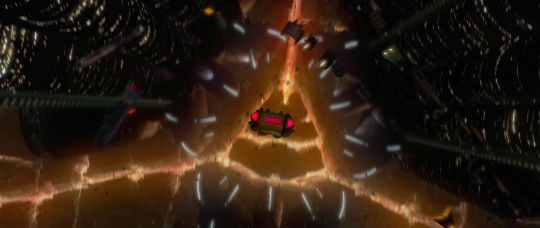
(Larger version here and secondary reference image here.)
- THE SENATE DISTRICT - Most known for housing the enormous Galactic Senate Building, it also contained high class living quarters and shopping malls and restaurants and several species’ Embassies and even at least one hospital. Especially notable locations were:
Senate Building, which is primarily known for housing the Galactic Senate Chamber, the meeting hall for the thousands of Senators. “Behind each Senatorial platform, almost a kilometer of offices houses the hundreds of workers needed to support each Senator.” Many of these are also modified for a given species’ atmospheric and biological needs or simply give a resting area for the Senator and their aides.



(Larger versions here, here, and here.)
Also in the Senate building, Palpatine has a “working office” just beneath the Senate Chamber. This is where his podium rests when not in use, before it ascends into the Chamber itself--this is also where Yoda goes to meet Darth Sidious towards the end of Revenge of the Sith.
500 Republica, the most exclusive residential tower on Coruscant and was located in the Ambassadorial Sector of the Senate District. (Padme stayed here as a guest of Palpatine’s during the Invasion of Naboo. Also referenced here.)
Senate Apartment Complex, which was a short distance away from the Senate Building. Padme’s apartment during her time as a Senator was located here. (Senate Apartment Complex shown here and here in Attack of the Clones.)
Skysitter Restaurant, which was a thousand stories high, famous, and only the wealthiest Senators could afford it.
Galactic Museum, which was a massive historical museum of various and myriad cultures, so large that it would take days to fully explore. Sometimes they also funded expeditions to uncover lost relics.
Galactic Senate Medcenter, which was the top five stories of a non-descript mid-level building and was set up exclusively for the Senators and was accessible by a turbolift from the Senate Building or a skybridge from the Embassy Mall or accessible via an airspeeder.
Calacour Heights, the marketing district known as the Calocour Heights resembled a miniature Corporate Sector. Found here: Survey-takers, product samples on repulsor-lift carts, and a crapload of billboards. Why you'd go there: Looking for cutting edge gadgets! You'll pay an arm and a leg, but you'll get quality. It was situated in the Senate District. (Referenced here.)
Galactic Justice Center was a massive government building on Coruscant. Located in Quadrant A-89 of the Senate District and contained several courthouses and other judicial and law enforcement facilities.
- SENATE OFFICE BUILDING - It was also called the Republic executive building or Senate executive building, it was the lower dome shaped office building we see here. It was where the offices of many Senators were, had a number of landing bays, and Chancellor Palpatine’s office. It was located in the Legislative Borough of the Senate District, had many docking bays and hangars for official transports. It was created to alleviate the growing need for office space as more and more systems gained Senators, and we know both Padme and Bail’s offices were located here. (The Clone Wars episode Hostage Crisis takes place here.)
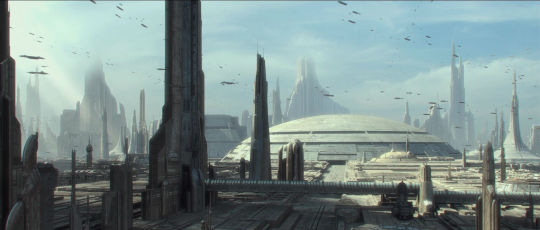

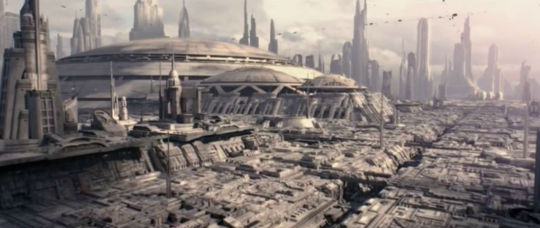


(Larger versions here, here, here, here, and here. Wookiepedia has more images here and here. Its docking bays are here.)
Chancellor’s Office / Chancellor’s Suit, which was the office we all know from the movies and TV shows--though, it’s expanded upon in Complete Star Wars Locations. There is the main foyer and office, but off to the side are a small bedroom, wardrobe, and private fresher, as well as a secondary private office to deal with more private (and often times Sithly) matters.
There’s a Statue of Sistros (along with the other Four Sages of Dwartii) in the main part of his office, where his lighstaber is hidden, a small office for his aides to work in, and and a hidden emergency escape turbolift.
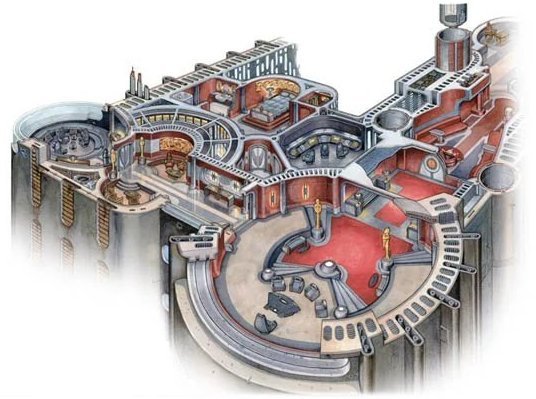
(Larger version here and here.)
Padme’s Office and Bail’s Office (from the Revenge of the Sith deleted scenes) were here as well.
- THE TEMPLE DISTRICT - While I’ve covered the Jedi Temple itself elsewhere, the District it’s centered in itself doesn’t get a lot of coverage. There is a simple map to show the general layout, though:

(Larger version here.)
But it was likely there were at least some entertainment businesses or residential apartments scattered along the edges, as well as various government buildings. As the Clone War went on, though, it accommodated more hangars and military supply installations there as well.
- COLUMN COMMONS - This mid-level district featured large, open areans interspersed with fat colums that supported the "ceiling" levels of cityspace overhead. What you'd find her: Holodrama and newset publishers had offices here, the major news bureaus were here. Why'd you go there: If you need to find a reporter, here's where you'd go. (Referenced here.)
- SOUTHERN UNDERGROUND - The Southern Underground district located near the south pole and it contained a hemispherical shopping center stuffed with run-down stores and impromptu barter stalls. Why you'd visit: If you’re in the Coruscant Undgeround and needed a quick, if dirty, place to shop, here’s your district to head towards. Just watch out for the stone mites and duracrete slugs. (Illustrations on Wookieepedia here and here. Also referenced here. )
- COCO TOWN - (Wookieepedia link here, Legends here.) An ecclectic area of Coruscant, it’s mostly known to us for where Dex’s Diner was located. Some areas were more run-down, some areas catered to many of the municipal and construction workers of Coruscant, and some areas were more exclusive stores. There were a lot of middle scale diners and hotels/cantinas, but also at least one theater and a branch of the Galactic Museum [see above].
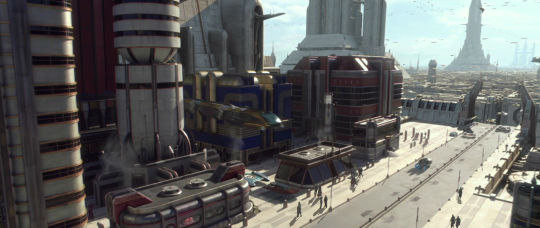
(Full images here.)
- WORKS - This was also called the Industrial District, which was once a manufacturing powerhouse, but by the time of the Clone Wars, it was largely abandoned (to have manufacturing moved off-world where it was cheaper) and we see it mostly used for shady meeting places. There were some attempts to clear the space out with duracrete slugs, stone mites, and conduit worms so it could be purchased and refurbished, but that didn’t seem to go much of anywhere. (Wookieepedia pages here and here.)
- FINANCIAL DISTRICT - Here is where you’d find a collection of banks, accounting related business offices, and wealthy businesses made their offices here. It bordered the Senate District, was about 12 square miles, and wasn’t to be confused with the Business District, though they often overlapped.
- USCRU DISTRICT - (Wookieepedia link here + the Entertainment District and Entertainment District/Legends.) While the evolution of this area is a little convoluted, how it seems to have ultimately ended up is--the larger district is the Uscru District, but the lower levels (which are part of the larger district) was called the Entertainment District and was where you could find a lot of seedy bars and clubs, with a lot of gambling and drinking. This is where the Outlander Club (cross-section here) from Attack of the Clones, where Obi-Wan and Anakin chase after Zam Wessel. The Galaxies Opera House [see below] could be found in the upper levels of this district as well.
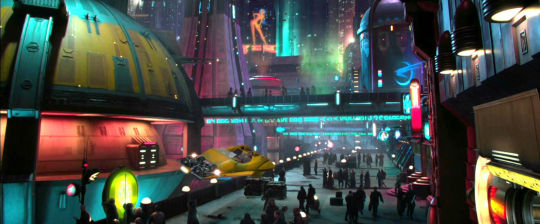
(Larger and expanded version here.)
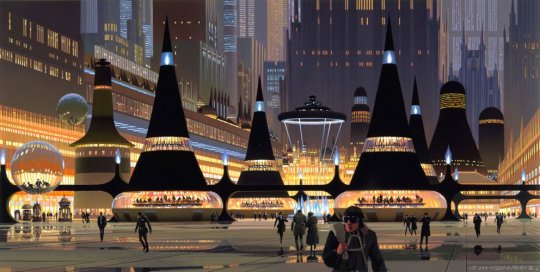
(This piece Ralph McQuarrie Coruscant Concept Art is likely the Uscru Entertainment District.)
→ ENTERTAINMENT ATTRACTIONS:
- The RPG Guide Coruscant and the Core Worlds has several listed points of entertainment! Including: the Coruscant Opera House, Skydome Botanical Gardens, Westport, Calocour Heights, Column Commons, the Southern Underground, the Invisible Sector, etc. (Full image here.)
- Coruscant Holographic Zoo for Extinct and Exotic Animals (post with Coruscant’s section here) - While the focus is on Alderaan (which wouldn’t be destroyed until 19 years into the Empire’s reign) in the Wildlife book, it has appeared chronologically before that, so you can still use the framework for an attraction that a tourist might want to see or a meeting place between two undercover agents if you’re writing PT-based fic. Also includes a handful of other species’ specialty animals! Qui-Gon and Obi-Wan visited it during a mission in 37BBY. (Relevant pages here and here.)
- Galactic Museum - [see above]
- Galaxies Opera House appears in canon (where Palpatine and Anakin have the conversation about Darth Plagueis) and in concept art here. Located in the Uscru Entertainment District.
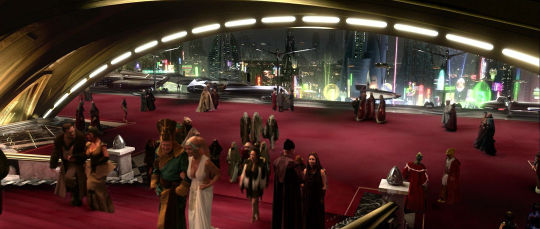
(Larger and expanded version here.)
- Coruscant Opera House is a separate opera house with a bit more history to it, it tended to be more exclusively for the rich. While it had a public area that poorer people could watch via holograms, it was relatively small and very upscale. (Referenced here as well as a bit more information/history on it here..)
- Skydome Botanical Underground attracted two types of visitors: bookish botanists and those who simply loved beautiful things. It was full of rare and beautiful plants and public tours frequently solid out months in advance. Likely also served for conservation purposes or study purposes. (Referenced here.)
- Leisure Satellites - “Vast space stations that traveled from planet to planet, bringing with them as many opportunities to relax as there are species in the galaxy. Be it games of chance, cutting-edge fashion, or even the thrill of high speed!” These were pretty massive space stations, you can see that they’re large enough to host entire podracing venues at the very least. It seems like these two stories take place on the same giant satellite, so you can see that they were significantly large, but either way, if you need something for characters to do to relax (even Jedi apparently go to them!), there’s plenty of opportunities here! (Referenced here, here, here, and here. You can see that in these moments they’re hovering over the Senate District and the Jedi Temple District, which is presumably along the equator. Referenced here and here.)
- The Ghost Ship - The giga-class transport ship Ultimo Vista that Anakin and Obi-Wan narrowly avoid hitting is one of Coruscant's most bizarre sights. Established decades ago as a leisure cruise ship, it is now a separate, contained world in which its elderly passengers are full-time residents. Almost entirely self-sufficient, the slow-moving craft endlessly circles Coruscant on its original route to nowhere. (Referenced here. Illustration here.)
- Circuses and wildlife exhibits - [see Animal and Plant Life below]
→ THE UNDERWORLD
When trying to figure out just how the upper layers work with the lower layers, the Atlas profile says about the planet’s history, "The megalopolis that would one day become the Galactic City is said to have already stood layer upon layer as early as 90,000 BBY." When looking at caps of the Coruscant Underworld, it seems as though there are buildings attached to the underside of something almost like a shell around the entire planet. As best I can tell, there is a shell over the Underworld that the surface of Coruscant is built on top of.
It’s difficult to get a feel for the Underworld, about the best I could reasonably do is look through the moments we get in The Clone Wars and make some observations:
- The most common way to get into the Underworld seems to be through the Underworld Portal, that giant tunnel we see ships lowering themselves through. Along the way there are many, many docking bays and landing platforms and Terminals/stations, and that the Underworld comprised of at least 1,300+ levels.
- Some of the landing platforms have thoroughfares that head straight towards the main “area” of the Underworld, but probably not all of them.
- The majority of the Underworld seems to be strewn with brightly colored lights from neon signs and some street lamps and the light spilling out from storefronts, that it’s dark and nighttime-like even when we know it’s daylight on the higher levels of Coruscant. There are dark alleyways without much light that one would need to be careful of, but in the main thoroughfares you can see perfectly well by the light of the signs.
- While many of the posters that are put up (and there are posters EVERYWHERE or graffiti all over the place, there’s hardly any clean, blank surfaces in the Underworld) there are also brightly light holoscreens that can display things like wanted posters.
- In addition to the neon lights being plastered on everything (including steps and walkways to help keep things semi-lit and to see where you’re walking), there’s a lot of steam pouring out from businesses in the area, there’s probably not much elsewhere it can go, so it lingers as smog in the air even more than it would above the ground.
- It doesn’t seem to be a terribly long walk before you’ll hit some factory areas, some of which may be more populated/manned than others.
- There are feral animals that can be round scurrying around. We know there are Tookas and other animals for sure, as well as Legends has conduit worms and duracrete slugs.
- It’s large enough that it has air traffic floating through the air, at least in the more open areas near the Underworld Portal(s?).
- It’s a mishmash of unorganized construction, which means there are small catwalks and platforms everywhere.
- At least some streets are wide enough that there are land speeders driven or parked along the roads.
- There’s some public transportation including a rather dirty public tram/subway and public turbolifts.
- There are public (whether they require a fee or not is difficult to discern) comm stations, though, whether they’re in working order or not is another matter. Even the darker, less used alleyways seem to have them.
Star Wars 1313 concept art also has some really interesting designs for the Underworld and the Underworld Portal! You can find them here, here, here, here, and here. There’s not much new to be gathered, but there’s some really cool detail and something of a sense of scope!
Also, [see above] for significant districts located in the Underworld.
→ ANIMAL AND PLANT LIFE
- The Wildlife of Coruscant is a good place to start! They mention:

- Silica parasites (duracrete worms, granite slugs, and shadow barnacles) which are silicon-based invertebrates that feed upon building structures. They are very destructive--annually causing millions of credits' worth of damage. There are also duracrete slugs that fall into the same category. (Referenced and illustrated here.)
- Hawkbats - Predatory reptavians, hawkbats ride the thermals rising from the bowels of the city. Though to be the only native Coruscant species left in existence. Hawkbats are officially protected because they feed on destructive silica parasites. (Referenced and illustrated here and here.)
- Mutant Rats - These giant, nearly skinless rapacious rodents inhabit the lower levels and sewers. (Referenced and illustrated here.)
- Dianoga - Large mollusks found throughout the universe, dianoga are used by many in sewage treatment. Occasionally, there are residential problems when there’s backup and you might get a few tentacles wriggling up through your space toilet. (Referenced and illustrated here.)
- The Animal Trade + Fugitives - Traders, brokers, trappers, and hunters bring specials from all over the universe to dealers (sometimes pet stores, sometimes not), who sell the animals as pets, zoo animals, livestock, etc. (Referenced and illustrated here and here.)
- Circuses - Circuses, carnivals, and spectaculars featuring exotice species from all over the galaxy visit Coruscant every year. They are very popular and give many their only chance of seeing rare animals.- (Referenced and illustrated here.)
- Livestock Exchange and Exhibition - Every year, the largest livestock fair in the galaxy is held in the stables, corrals, and halls of the Grand Symposium, a major event for animal dealers and traders of all sorts. - (Referenced and illustrated here.)
- Senators and their Menageries - Being the diplomatic headquarters of the galaxy, Coruscant hosts countless diplomats and ambassadors who establish permanent or semi-permanant residencies on the planet. These diplomats naturally bring pets from their home planets and/or acquire additional creatures during their tenure. (Referenced and illustrated here.)
- Coruscant Holographic Zoo for Extinct and Exotic Animals - [see above] While much of this will only apply to after Alderaan’s destruction, the zoo already existed pre-TPM, as you can find above. (Reference and illustrated here, here, and here.)
→ MUNICIPAL WORLDBUILDING:
- Garbage pits were spread across Coruscant to accommodate the massive amounts of waste and were filled with garbage worms--useful for a good place to crash if you want your Jedi or bounty hunter to have a bit of a messy, trouble landing, but could probably still survive and need rescuing from. (Further info here.)
- The Grand Republic Medical Center was a large, extremely tall hospital managed by the Republic during the Clone Wars, though, would later become Emperor Palpatine’s more personal Surgical Reconstruction Center (in Legends). It wasn’t until after the “incident with the renegade clone” that Palpatine would move his Sith artifacts here, though. The building appeared in The Clone Wars and Revenge of the Sith, it was where the construction of Darth Vader took place.
Before that, though, it’s unclear if it was for government officials or a more public hospital. But it seems likely that it was a public hospital, given that the cross-section mentions that, to the public, it was a medical facility that took on specialized cases from all across the galaxy and “Sith patients can arrive like regular patients”, not realizing the truth of what it really hid.
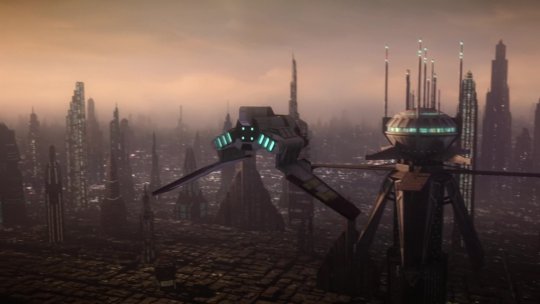
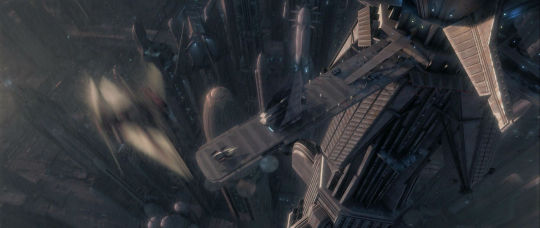

(Larger versions here, here, and here.)
- Senate Landing Platforms were privately reserved for the Senators, aids, and visiting dignities. The public landing platforms were often so busy that a vehicle may have had to wait hours in a holding pattern before one was available.
- Coruscant Air Traffic Control monitors the skylanes traffic, though, they’re also magnetic and guide ships along specific paths.
- Coruscant Weather Control Network, aka the WeatherNet, modulated the planet’s weather.

- Coruscant Park was a park located near the Jedi Temple on Coruscant. Jedi Masters often took their Padawans to the Park for training. (Probably less common than using the rooftop gardens on the Temple, but occasional field trips wouldn’t have been out of the norm.)

- Coruscant Green Park was an endangered park area and posters were put up to help save it. You can see the poster with the tree and building here.
- Giant billboards for advertisements or government announcements could be seen strewn between buildings many times. (Reference here, here, here, and here.)
- Construction was likely a daily obstacle in any given area of Coruscant, as it was literally constantly being built upon and build upon. (Reference here.)
380 notes
·
View notes
Text
My Year in Books
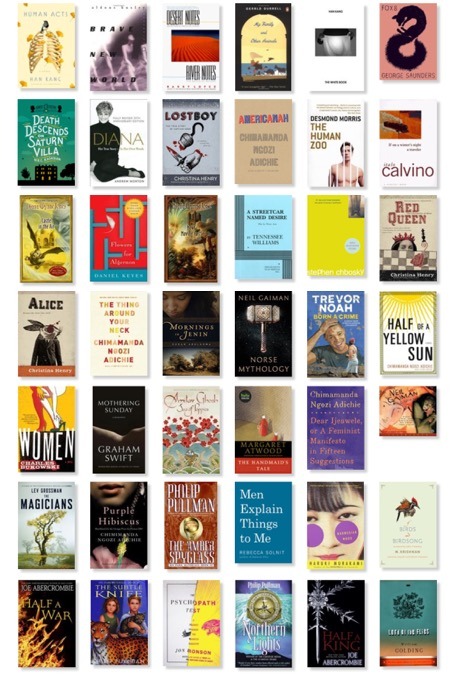
Dear Nobody
When asked if I’ve read a particular book, often all I would have to offer on the subject is a simple yes or no and perhaps whether I liked it or not. The interrogator might proceed to throw questions at me or share details about the book, which are usually met with a blank expression and/or a shrug. And as is usually the case, I will then be asked why I read so much if I can’t remember a thing about the book afterwards. I suppose I read purely for pleasure. I read so that I can lead many lives, look through new eyes, walk in someone else’s shoes, experience a range of emotions that I normally wouldn’t in my day-to-day life. I read so that I can learn new things. I read so that I can transcend myself. I internalize elements that I like in the books I read and then let them go. I don’t read to remember, although if something does stick in my memory, that’s great too.
Since 2014, I’ve set myself a Reading Challenge on GoodReads at the start of every year. It was this blog post by scientist and role model, TR Shankar Raman, that inspired me and continues to do so. Some years I complete the challenge, some years I don’t, depending on where I happen to be in my life at that point, both physically and metaphorically. It turns out that extended breaks in between jobs are great for reading, especially because one finds oneself broke and at home a lot.

Most of 2017 was spent at my field site in a remote corner of Arunachal Pradesh with atrocious cellphone connectivity. I had to come up with a way to keep track of my reading challenge without GoodReads.
This year’s challenge was a modest 42 books, which I’m happy to report I completed earlier this month! Overall, it was a fun year for reading. I surprised myself by reading far less Fantasy & Sci-Fi than I usually do. Not at all by design, I ended up reading quite a few works of fiction and one memoir written by people from non-Western regions of the world – India, Nigeria, South Africa, Palestine, South Korea, Japan – and I’m glad for it because I feel like I have delved a little into the history and culture of these places, carrying them around like a collection of mental postcards wherever I go.
I first discovered Chimamanda Ngozi Adichie when I watched her TED talk ‘The Danger of a Single Story’ back in 2009, making a mental note to read her first novel Purple Hibiscus. I finally got around to it this year (Procrastination 101) and boy, I fell in love with the narrative, the characters, the way Adichie doesn’t tell you what to think but describes everything in beautiful detail (never failing to activate all the senses) and allows you to arrive at your own conclusions. I then went on to read her other books – Half of a Yellow Sun, Americanah, The Thing Around Your Neck, Dear Ijeawele Or a Feminist Manifesto in Fifteen Suggestions – in quick succession. Through her writing, I learnt about the Biafran War (which I’d never heard of until that point), Nigerian cuisine (ah, I could almost taste some of it!), attire, what life is like growing up in a university campus in Nsukka or as a ‘Big Man’ in Lagos. I got a glimpse of sexism, religion, and the political history of the country that was forced into being by the British Empire. Chimamanda Ngozi Adichie is one of the three people I would love to write like, the other two being Vladimir Nabokov and William Dalrymple.
My book of the year was Flowers for Algernon by Daniel Keyes, one that I would wholeheartedly recommend to just about anyone. Because it doesn’t matter who you are or where you’re from or what genre you stubbornly adhere to, this book will pluck at your heartstrings. A warning at the outset – it will not be easy, you will explore the dark side of human nature, the book will become a mirror that shows you parts of yourself that you would rather not acknowledge. You will never truly recover from the reading experience. But I can assure you that you won’t regret it. The book is in the form of progress reports written by Charlie Gordon, a borderline mentally disabled person with an IQ of 68 who works in a bakery. He has signed up for an experiment which, having been successfully carried out on a mouse named Algernon, is to be tested on humans for the first time. If successful, this scientific breakthrough will increase his intelligence by manifold. Charlie is excited about the prospect of becoming smart like his friends at the bakery. Reading through his progress reports, you are part of the process as Charlie begins to change, slowly at first and then in leaps and bounds. You watch as his relationships with the people around him change, as they start to treat him differently and he starts to realize the cruelty he was subject to. We also get glimpses of his painful past as his childhood memories resurface. In the meanwhile, at the peak of Charlie’s intelligence, Algernon has begun a sudden and unexpected deterioration, and eventually dies. What does this mean for Charlie? Ah, how can I possibly explain the range of emotions that this book evokes! It’s a journey of the soul.
Alice by Christina Henry was another great find this year. It’s a dark retelling of Alice in Wonderland, all the more delightful for being gory and macabre. Alice finds herself locked away in an asylum, but she can’t remember what happened to her or how she landed up there. She only remembers a man with rabbit ears. I won’t say any more about it – you’ll just have to see for yourself! After the spectacular first book, I was quite disappointed to read Red Queen, which I thought failed on many fronts but mainly in terms of plot. But if you like Henry’s style as much as I do, you could skip the second book and move on to the morbid world of Peter Pan in Lost Boy instead.
Other books I would recommend are Born a Crime by Trevor Noah (hilarious, charming and eye-opening account of his childhood in South Africa in the post-apartheid era), Diana: Her True Story in Her Own Words by Andrew Morton (biography of Princess Diana, which I read only because I knew nothing about the Royal Family, it was an interesting read), Howl’s Moving Castle by Diana Wynne Jones (so much fun!), Women by Charles Bukowski (for his style), and The Perks of Being a Wallflower by Stephen Chbosky (better than the movie).
I have this strange compulsion to finish any book I start, no matter how awful. If you suffer from the same disorder, then I would advise against picking up the following books: The Magicians by Lev Grossman (the characters suck, the plot sucks, the writing sucks – apparently it’s a trilogy, I steered clear of the second book), Half a King by Joe Abercrombie (didn’t find much to like, but started the second book to see if it could get any worse, then finished it before I realized I’d been reading the third book, so I accidentally read the trilogy – sort of), Brave New World by Aldous Huxley (mmm, I didn’t enjoy it one bit, I think I only like his writing when he’s on mescaline).
2017 was also a year for audiobooks. Up until now, I was on the fence about them. Would my mind drift while listening to a recording of someone reading a story? What if I didn't like the narrator? And since I like reading, re-reading, and mulling over particularly well-written lines, I dreaded the thought of having to navigate my way through the forward-back controls and the minutes and seconds of the aural world. Despite these concerns, I downloaded Philip Pullman’s triology, His Dark Materials. All three audiobooks were fantastic and I had a great time listening to them. I also found that audiobooks are a great companion to have when you can't read (easily) - in the shower, while exercising or doing the laundry, while commuting, you name it. And of course, there's nothing like snuggling up under the blankets and falling asleep to a bedtime story.
I’m currently reading The God of Small Things by Arundathi Roy and wondering about what my target should be for next year’s Reading Challenge. In the meanwhile, do you have any recommendations for me to add to my 2018 shelf?
Love,
D
1 note
·
View note
Text
'Mass Effect: Andromeda' review: A sprawling space drama that struggles to stay on target
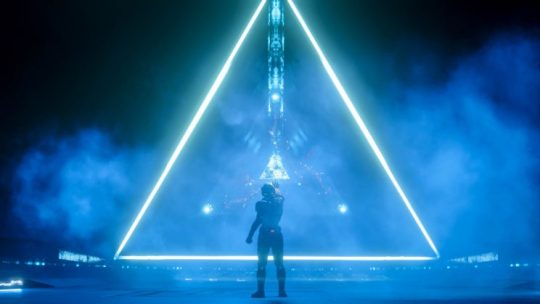
‘Mass Effect: Andromeda’ invites you to strap in for another space opera.
“Space is big,” beloved author and interdimensional traveler Douglass Adams noted in his seminal towel-seller, “The Hitchhiker’s Guide to the Galaxy.” “You just won’t believe how vastly, hugely, mind-bogglingly big,” he wrote, hammering home the point that when it comes to bigness, even our new president has nothing on the universe.
That size presents quite a challenge to game makers, but few have hacked away at the quandary with as much gusto as developer Bioware. The team behind the blockbuster “Mass Effect” trilogy managed to capture the epic scope of the big unknown while keeping our eyes trained on the intimate interactions between characters, a space opera in its truest — and, in terms of video games, among its best — form. So when they announced a return to their beautifully realized universe with “Mass Effect: Andromeda” ($60 for Xbox One, PS4, PC), we all got very excited indeed.
But a great deal has happened since 2012’s “Mass Effect 3” simultaneously wowed and enraged gamers; namely, “The Witcher 3,” “Fallout 4,” Bioware’s own “Dragon Age: Inquisition” and a host of other genre-blending RPGs (you could arguably toss recent greats “Horizon: Zero Dawn” and “The Legend of Zelda: Breath of the Wild” into that mix, too). Big-budget role-playing games have blossomed in the past five years.

‘Mass Effect: Andromeda’ has the makings of a great game, but misses the mark with a number of missteps.
And unfortunately, “Mass Effect: Andromeda” picked up some unwelcome visitors on its long journey to your gaming machine. Though it has some stellar moments, “Andromeda” tries to cram too many ideas into one package, turning its obsession with the bigness of space into a crutch for uncharacteristically shoddy workmanship.
The (next) final frontier
To answer your most obvious question: no, you do not need to have played the prior “Mass Effect” games to understand what the hell is happening here. “Andromeda” tells a self-contained story featuring entirely new characters, planets and star systems, though references to elements from the original trilogy (the Citadel, the Geth, Spectre, etc.) do occasionally pop up.
The game is set roughly 600 years after the events of the original trilogy. Just as things were heating up in the Milky Way (around the “Mass Effect 2” timeframe), several giant Ark ships were launched towards the faraway heart of the Andromeda galaxy. Snuggled in cryo beds and dreaming of a new life, the adventurous souls aboard these vessels were hoping to discover habitable new worlds and plant some flags.
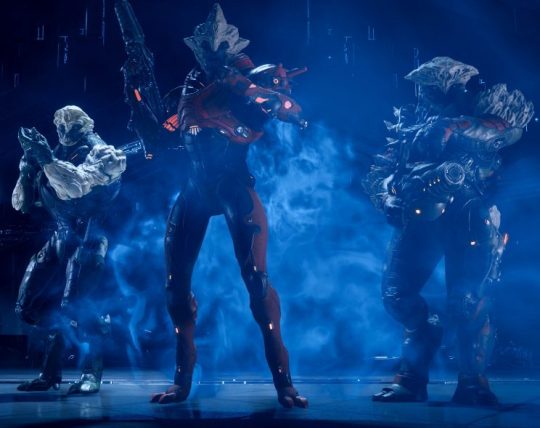
‘Mass Effect: Andromeda’ sees you exploring the Andromeda galaxy for a new home. But – spoiler alert – things go very wrong.
Naturally, things go sideways. You play as either Scott or Sara Ryder, a twin thrust into the role of ‘Pathfinder’ and tasked with guiding a ragtag group of aliens in a quest to find a new home. It’s all pretty standard sci-fi stuff — a bite of “Star Trek,” a nibble of “Battlestar” — but Bioware crafts a well-told tale that rises above its derivative vibe to keep you, um, engaged throughout.
Mostly, that’s done though a tweaked version of the branching narrative structure Bioware is known for. Conversation options have expanded beyond the binary Paragon/Renegade of prior games, adding flexibility and giving you a bit more agency over your particular Ryder. Despite some nasty bad guys and extremely high stakes, it’s also significantly more lighthearted than the trilogy’s dour doomsday scenario. Regardless of how you play Ryder, he (or she) is quick to joke and seems intent on keeping the joy of discovery intact.
The dialogue system isn’t as thrilling as it used to be, however. Other franchises have taken the cue and built branching narratives with greater emotional value. “The Witcher 3,” “Life is Strange” — heck, the entire Telltale Games catalog (whose Season 1 of “The Walking Dead” bested “Mass Effect 3” in most 2012 Game of the Year Awards) have pushed the envelope of branching narrative design, making each choice feel impactful. Though your tone changes based on your responses in “Andromeda,” Ryder’s playful, at time snarky attitude takes some of the gravitas out of the decision-making. You rarely break a sweat.

‘Mass Effect: Andromeda’s’ dialogue system lacks the kind of gravitas that makes games like ‘The Witcher 3’ so addictive and powerful.
Still, developing relationships, opening/closing paths, trying to get busy with a blue lady — it’s all here, and thanks to an interesting story, likable characters and great voicework by both male and female Ryders, “Andromeda” does a convincing job of turning you into Captain Kirk.
A downright uncanny job, you might say.
Valley of the Dolls
Unless you’ve been avoiding the internet for the last week, you’ve likely caught wind that gamers are, to put it mildly, displeased with the “Andromeda’s” animations, particularly its facial close-ups. And, well, yeah, the facial animations aren’t great. The game doesn’t just glide over the uncanny valley, it builds a big space house and moves right in.
I typically don’t put too much stock in this; plenty of outstanding games are kind of ugly up close (I’m looking into your lifeless eyes, “Fallout 4”). What makes it so rough here is the amount of time you spend staring at close-ups. A good third of the game is spent chatting with people and developing relationships, but when they look like broken robots, it breaks the spell. About halfway through the game, my Ryder inexplicably developed two wicked lazy eyes that lasted for a good 10 hours.
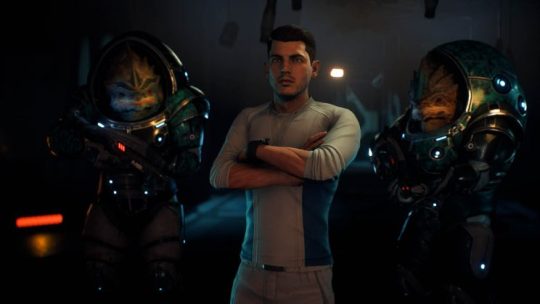
‘Mass Effect: Andromeda’s’ human characters look like dead-eyed androids.
Perhaps the increased power of modern consoles/PCs (I played on PS4) is the culprit — as the theory goes, the closer you get to reality, the deeper the valley. But as ugly as it gets for humankind, the power leads to some amazing aliens. The brutish, dinosaur-like Krogans have never looked better, and jittery eyes and smooth skin give the amphibious Salerians incredible life. I relished every chance to chat with non-humans, both to bask in Bioware’s great work and as a respite from the mannequin onslaught.
This sort of uneven delivery extends to the rest of the game’s graphics. The art design is triumphant – Issac Asimov would commend the look and feel of the game’s colorful terrain, sweeping interstellar views and massive starships – but technical glitches abound. Flickering textures are common, load times are excessive and occasional pop-in mars the stunning planetside vistas. These sorts of glitches aren’t game-breaking, but they speak to a project struggling to bear its own weight.

Humans might not look good in ‘Mass Effect: Andromeda,’ but the aliens are gorgeous.
Galaxy quest
And make no mistake: “Andromeda’s” scope is massive.
Much of the game takes place on explorable planets that are significantly bigger than the regions found in “Dragon Age: Inquisition.” You can spend hours scouring the nooks and crannies of each location from the comfort of your Nomad rover. And as you find ways to make life more hospitable, the areas open up even further.

‘Mass Effect: Andromeda’s’ worlds are vast and beautiful.
A star map gives you free reign to explore the Heleus cluster of the Andromeda galaxy. You can only land on and explore a handful of planets, but you rarely feel hemmed in, and the desire to build outposts pushes you to approach Andromeda like a real pioneer. It’s a good hook.
But this goal is quickly buried beneath a ridiculous number of less essential Things to Do. Some are classic “Mass Effect” – your shipmates have needs, and if you want to unlock their highest-level abilities or get them into bed (perv), you’ll need to attend to those — but you pick up other, seemingly unwanted side quests with alarming ease.
Checking in on an outpost? Be careful who you talk to, because apparently every single life form in the galaxy is incapable of handling their own business. Even if they don’t have a gigantic exclamation point on their head, they’ll probably ask you to shuttle something somewhere or look into a mild, pointless drama. And you’ll feel pressed to track down every one, because you never know which insignificant-sounding rabbit hole will yield some legit XP or loot.

‘Mass Effect: Andromeda’ piles on the quests like every other RPG, but organizes them poorly.
This is fairly common to RPGs, but “Andromeda’s” flood of quests is compounded by terrible quest tracking. A Journal ostensibly keeps tabs on them, but inexplicably lists them based on where you picked them up rather than where they are located in the world. It’s a crazy way to organize quests; land on a planet and you’ll have to either scour dots on the map or rummage through your Journal to figure out what, if anything, you’re supposed to do there.
This alone drove me nuts. I may be a real-world organizational disaster (I am a writer, after all) but this is definitely a trait I don’t want to carry into my sci-fi power fantasy.
Laser tag
On the other hand, I did get to carry lots of guns. And this is one area where “Andromeda” really fixes something.
The game does a fine job of improving and even amping up “Mass Effect’s” combat. Jump jets and a handy dash make you far more maneuverable, which is a boon since you contend with enemies in open-world locations. Skills and proficiencies can totally alter the way you play. Focus on Combat to be a Rambo, invest in Biotics to be a Jedi, stick with Tech to hurl fire and ice, or spread the wealth and be a bit of each. Deep but approachable, the system serves as a solid backend for the on-the-field action.
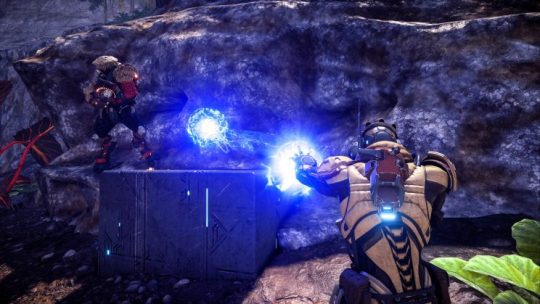
If there’s one thing Bioware improved for ‘Mass Effect: Andromeda’ it’s the game’s combat.
I forgot exactly how shooty “Mass Effect” was, and once you get used to the fact that you’re not playing a game quite as refined as the “Halos” and “Horizons” it attempts to ape, it falls into a pleasant rhythm. Nice touches abound, like jumping and pausing in the air for a few seconds while aiming down your sights. Experimenting with different abilities is also a snap thanks to a handy respec option, quelling the FOMO that rules most games that force to to stick with one class. It’s flexible and fun. Bioware upped their game here, for sure.
But it isn’t perfect. The wide-open universe only yields a handful of enemy types, and none of them are particularly exciting. You have little control over your two fellow squadmates, and the weak enemy A.I. means you never need to think strategically when deciding which companions to bring into battle. I mostly stuck with the Krogan warrior because he looks cool. A baffling “auto” cover system claims that you just need to move close to an object with your gun drawn to hide behind it, but it doesn’t work very well. It just ends up getting you shot a lot, even when you think you’re safe.

You want jump jets? You’ve got jump jets.
Systems overload
“Andromeda” just doesn’t know when to quit, layering on screen after screen and system after system to make even the simplest task, like equipping a hot new weapon, painstaking.
Find a gun? You’ll need to head back up to your ship or find a “forward station” to switch your loadout, because, well, who knows. Tiny, uniform iconography turns inventory management into a slog. You know the thrill of finding and ogling a gorgeous, exciting new rifle in “Destiny?” That ain’t here.
Scanning planets for resources takes forever due to pretty but infuriatingly slow pans and zooms. Tracking down a specific resource to, for instance, craft a new helmet, is a total crapshoot. Bioware’s focus on the big picture has left a surprising number of holes in its basic RPG foundation.
They even tossed in co-op multiplayer, because it’s 2017 and I think that’s required by law now. “Mass Effect 3” toyed with this and it returns largely unchanged, as you and some pals clear out waves of increasingly stubborn baddies. It’s got its own progression system and offers a decent break from the RPG slog, though considering the core game could take a good 80 hours to complete, I’m not sure anyone needs it.
So do they need “Mass Effect: Andromeda” at all? That’s a tough call. A cool game is buried beneath “Andromeda’s” issues. When the guns are on point and you’ve exploded a Biotic combo, or when the ramifications of some difficult choice made hours ago comes back to haunt you, “Mass Effect: Andromeda” scratches that old space itch. But getting past the technical gaffes and unfriendly interface requires a great deal of patience. Space is big, indeed, but it’s supposed to be fun, too.

Platform reviewed: PS4
What’s hot: Cool story; outpost settling is a good hook; improved maneuverability; deep combat options
What’s not: Technical issues; aggravating interface; seriously uncanny valley; quest quantity over quality; dated feel
More games coverage:
‘Middle-earth: Shadow of War’ lets you lead orcish armies — and destroy them
Nintendo Switch launch games: The must-haves, the maybes and the probably nots
‘For Honor’ review: You’ll need skill to survive this online fighter
‘Horizon: Zero Dawn’ Review: Combat and storytelling shine in spectacular sci-fi epic
The $450 Analogue Nt mini brings new life to old-school NES games
‘Resident Evil 7’ review: It’s a screaming good time
Ben Silverman is on Twitter at ben_silverman.
#gaming#_revsp:yahoofinance.com#Mass Effect#games reviews#_author:Ben Silverman#Mass Effect: Andromeda#video game reviews#Mass Effect: Andromeda review#_lmsid:a077000000BAh3wAAD#reviews#game reviews#_uuid:c94944b9-14e5-3c4f-83e6-5d5367276538#video games
2 notes
·
View notes
Text
Why Is Asheville North Carolina So Cool?
Fun Things To Do In Asheville
Asheville, North Carolina
Asheville has to be one of the coolest small cities on the East Coast, with a relaxed bohemian vibe and adventurous spirit. Here are some fun things to do there!
Located in North Carolina’s scenic Blue Ridge Mountains, Asheville has a unique mix of hipster coffee shops, award-winning restaurants, outdoor activities, and more breweries per capita than anywhere else in the United States.
After hearing about Asheville for years, whether from friends, or the Obama’s visiting on vacation — it was time to learn what all the fuss was about.
Why was Asheville rated the #1 US travel destination for 2017? Why does everyone think Asheville is so cool?
Pack Square Park
Travel Tips for Asheville, North Carolina
Things To Do In Asheville
Anna and I spent 4 days visiting Asheville in partnership with Explore Asheville Tourism, and had a wonderful time eating, drinking, shooting photos, and enjoying nature.
Asheville’s creative (and slightly eccentric) locals contribute to a lively downtown unlike any other. You can experience an intoxicating drum circle, shop at vintage boutiques, sit down to an amazing locally-grown meal, and admire cool street art all in one day.
One of the best ways to experience the city fully is by exploring on foot. With about 87,000 residents, Asheville isn’t huge. But it’s not too small either.
It feels like a large town, and just the right size. Asheville’s downtown in particular is easily walkable, with a charm all its own.
Asheville Street Performers
“Chicken Alley” Mural
Tons Of Art & Music
Asheville is known for its art scene, and you’ll quickly understand why. There’s fun street art all over the place, like colorful murals painted on the side of buildings & under bridges depicting the city’s history.
My favorite was probably “Chicken Alley” by Molly Must, which you can find on Carolina Lane & Woodfin Street. Two giant chickens watch over the alley, a place that used to be full of real chickens in the past.
In the 1980s artists began transforming a bunch of old industrial buildings along the French Broad River into studio space. Now the public can visit these studios as part of the Rivers Arts District and browse the work of over 200 local artists.
The town is full of small lounges, clubs, and breweries featuring live rock, jazz, and bluegrass. Many don’t charge a cover either.
Or you can check out some fun (possibly strange) street performances in the center of town. Don’t forget to tip if you enjoy the show! Asheville wouldn’t be the same without them.
Lexington Avenue Brewery
Pack’s Tavern
Beer City USA!
Asheville is known as “Beer City USA”. Because with 26 different craft breweries in the city, and another 60 nearby, beer lovers won’t want to leave.
Some of the most popular in town are Green Man, Catawba, Wicked Weed, and Lexington Avenue Brewery.
About 100 local beers can be enjoyed in Asheville, and each brewery has its own unique character. From strong hoppy IPAs to dark stouts, to fruity raspberry ales, you’re bound to find something you’ll love.
On top of the incredible beer scene, the city is also “steeped” in tea culture.
Check out Dobra Tea, afternoon tea at Biltmore, and The Herbiary.
Whitewater Stand-Up Paddleboarding
The French Broad River
French Broad River
The French Broad River winds its way past Asheville, providing a natural space for all kinds of outdoor activities & adventures.
You have your obvious river sports like whitewater kayaking and inner-tube floating, but there are some lesser-known activities here too, like “bellyaking” and whitewater SUP.
Bellyaking was actually invented in Asheville — it’s a face first kayak-type ride using special “paddle gloves” to maneuver through the rapids.
I decided to try some whitewater SUP (Stand Up Paddleboarding) for the first time with Wai Mauna SUP Tours.
Stand-up paddle-boarding through class I & II river rapids on the French Broad River requires a lot of balance, it was more difficult then the lake or ocean SUP I was used to. I fell a few times, but it was still fun!
Eating Our Foraged Food at The Marketplace
Salsa’s Restaurant in Asheville
Farm To Table Dining
Asheville is home to over 250 restaurants, many serving locally produced meats and veggies while supporting North Carolina’s farmers. They’ve been doing “farm to table” long before it became a cliche.
We obviously couldn’t try every restaurant in town with just four days, but my favorite places to eat in Asheville were The Marketplace and Salsas.
French Broad Chocolates is an ice-cream lover’s dream too. The line outside is long, but there’s a reason for that.
The chocolate ice-cream floats are sooooo good! It was worth the wait.
The Famous Biltmore Estate
George Vanderbilt’s Extensive Library
View Off the Back Deck
The Biltmore Estate
The historic Biltmore Estate is one of the most frequently suggested places to visit in Asheville. George Vanderbilt’s gigantic, hundred-year-old property is indeed quite busy all year long.
George, an heir to the Vanderbilt railroad fortune, fell in love with North Carolina and began building his property by late 1889. He decided to create a dream home surrounded by natural forests and productive farms.
This 178,926 square foot mansion sits on 8000 acres, with over 250 rooms, and is America’s largest home. The Biltmore holds regular exhibitions — they were displaying movie costumes used in films set during the XVIIIth century when we were there.
George Vanderbilt was one of the most-read men in America, and amassed a library of more than 22,000 books — including over 3,000 he read himself. Gazing at the walls of books in his preserved library was fascinating.
Wild Foraging with No Taste Like Home
Picking Chanterelle Mushrooms
Wild Foraging Tours
I’ve never been wild mushroom picking before, so we signed up for morning foraging tour with a company called No Taste Like Home.
Our day began with an overview from owner Alan Muskat about types of edibles we’d be looking for, and which poisonous plants to avoid.
After being equipped with baskets, harvesting knives, and paper bags, we headed into the enchanting North Carolina forest. I was completely surprised at how many things you could eat, and how good they tasted!
We collected Day Lily flowers, Chanterelle mushrooms, Stinging Nettle, Sassafras leaves, and strange mushrooms called Hairy Rubber Cups. While not popular in the US, they are apparently a delicacy in Malaysia.
After, you can bring your “catch” to local restaurants in Asheville like The Marketplace, where chefs prepare your dinner using the wild ingredients.
The Blue Ridge Parkway
Many Fun Hikes in the Mountains
The Blue Ridge Parkway
Nestled between the Great Smoky Mountains and the Blue Ridge Mountains, Asheville offers year-round access to hiking trails and exhilarating views along the famous Blue Ridge Parkway.
The complete route stretches 469 miles from North Carolina to Virginia, and is home to a wide range of diverse plants and animals. It’s technically part of the National Park System.
Along with hundreds of hiking trails, the parkway includes sections of the Appalachian Trail — one of America’s classic long distance hikes that stretches from Georgia to Maine.
Asheville was a perfect base for exploring the Blue Ridge Parkway, and we spent a full day cruising its winding pavement. Stopping occasionally at mountain lookouts and for short hikes to admire the area’s nature.
Looking Glass Falls
Sliding Rock Falls
Natural Waterslide!
Pisgah National Forest
Pisgah National Forest is located South West of Asheville, only 30-45 minutes away. It’s considered the birthplace of modern forestry in America, and home to the country’s first forestry school.
Driving through Pisgah on Route 276 is a fun little road trip complete with waterfalls, white water rapids, hiking trails, and camping opportunities.
We stopped by two different waterfalls. The first is called Looking Glass Falls. Located right off the side of the road, it’s super easy to reach, and a nice place to cool off in the summer heat.
The second is Sliding Rock — basically a huge natural waterslide made of smooth stone. A quick ride down the 60-foot flat, sloping boulder will definitely wake you up due to the chilly 50 degree water!
The Davidson River is a popular area for fly-fishing too.
Grove Park Inn
Abbington Green B&B
Places To Stay In Asheville
If you’re wondering where to stay in Asheville, here are my recommendations:
Grove Park Inn – Asheville’s most famous hotel is one of a kind. Built out of stone on the top of a hill, it features various restaurants, a beautiful spa, and scenic views of the city.
Abbington Green B&B – This has to be one of the best bed & breakfasts I’ve ever stayed at. Beautifully designed with a peaceful garden, tasty breakfast, and friendly southern hospitality.
Downtown Asheville
Asheville Travel Tips & Advice
There’s a fun public drum circle every Friday night between 6pm – 10pm in Pritchard Park, where people of all ages join in to dance to the music.
Asheville has a beautiful array of wildflowers that bloom between April and June. Keep your eye out for trillium, lady slippers, wild ginger, evening primrose, mountain laurel, rhododendron, and many more.
The best time to visit Asheville is during the fall foliage season (October), as trees & mountains are incredibly colorful. Summers are usually pretty busy too, and get the best weather.
Parts of the Appalachian Trail pass through this region. For a taste of this famous 2,180 mile trek, try hiking the Max Patch Mountain trail for great views.
The Biltmore Estate is Asheville’s most popular attraction, so it can get quite crowded. Go super early for awesome photos and less people.
Asheville has a little something for everyone. You can enjoy scenic mountain vistas, fun live music, locally produced food and beer, a vibrant arts scene, hiking and other outdoor adventure activities too.
I have to say it has become one of my new favorite mountain towns in the United States, and an excellent weekend vacation destination. Who knows, you may never want to leave! ★
Bonus Video! Things To Do In Asheville
Subscribe to my YouTube Channel for new Adventure Travel Videos!
(Click to watch Things To Do In Asheville – North Carolina on YouTube)
More Information
Location: Asheville, North Carolina
Plan Your Trip: Explore Asheville
Useful Notes: Asheville has it’s own regional airport that’s large enough for regular commercial flights. Some airlines that fly there include Continental, Delta, United and US Airways.
Recommended Guidebook: Asheville & Great Smokey Mountains
Suggested Reading: Only In Asheville: An Eclectic History
Pin This!
READ MORE FROM THE UNITED STATES
Hiking The Zion Narrows In Utah
Miami To Key West Road Trip
Hitchhiking Across America From Coast To Coast
Any questions about traveling to Asheville, NC? Do you have any other suggestions? Drop me a message in the comments below!
This is a post from The Expert Vagabond adventure blog.
0 notes
Text
Why Is Asheville North Carolina So Cool?

Fun Things To Do In Asheville
Asheville, North Carolina
Asheville has to be one of the coolest small cities on the East Coast, with a relaxed bohemian vibe and adventurous spirit. Here are some fun things to do there!
Located in North Carolina’s scenic Blue Ridge Mountains, Asheville has a unique mix of hipster coffee shops, award-winning restaurants, outdoor activities, and more breweries per capita than anywhere else in the United States.
After hearing about Asheville for years, whether from friends, or the Obama’s visiting on vacation — it was time to learn what all the fuss was about.
Why was Asheville rated the #1 US travel destination for 2017? Why does everyone think Asheville is so cool?

Pack Square Park

Travel Tips for Asheville, North Carolina
Things To Do In Asheville
Anna and I spent 4 days visiting Asheville in partnership with Explore Asheville Tourism, and had a wonderful time eating, drinking, shooting photos, and enjoying nature.
Asheville’s creative (and slightly eccentric) locals contribute to a lively downtown unlike any other. You can experience an intoxicating drum circle, shop at vintage boutiques, sit down to an amazing locally-grown meal, and admire cool street art all in one day.
One of the best ways to experience the city fully is by exploring on foot. With about 87,000 residents, Asheville isn’t huge. But it’s not too small either.
It feels like a large town, and just the right size. Asheville’s downtown in particular is easily walkable, with a charm all its own.

Asheville Street Performers

“Chicken Alley” Mural
Tons Of Art & Music
Asheville is known for its art scene, and you’ll quickly understand why. There’s fun street art all over the place, like colorful murals painted on the side of buildings & under bridges depicting the city’s history.
My favorite was probably “Chicken Alley” by Molly Must, which you can find on Carolina Lane & Woodfin Street. Two giant chickens watch over the alley, a place that used to be full of real chickens in the past.
In the 1980s artists began transforming a bunch of old industrial buildings along the French Broad River into studio space. Now the public can visit these studios as part of the Rivers Arts District and browse the work of over 200 local artists.
The town is full of small lounges, clubs, and breweries featuring live rock, jazz, and bluegrass. Many don’t charge a cover either.
Or you can check out some fun (possibly strange) street performances in the center of town. Don’t forget to tip if you enjoy the show! Asheville wouldn’t be the same without them.

Lexington Avenue Brewery
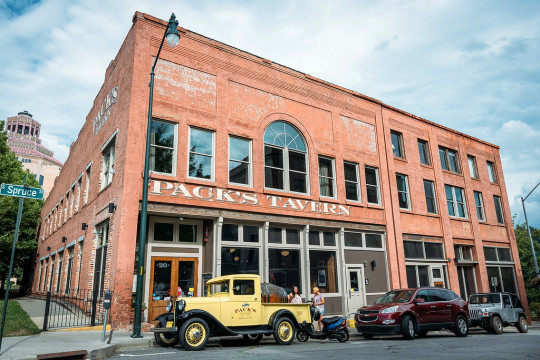
Pack’s Tavern
Beer City USA!
Asheville is known as “Beer City USA”. Because with 26 different craft breweries in the city, and another 60 nearby, beer lovers won’t want to leave.
Some of the most popular in town are Green Man, Catawba, Wicked Weed, and Lexington Avenue Brewery.
About 100 local beers can be enjoyed in Asheville, and each brewery has its own unique character. From strong hoppy IPAs to dark stouts, to fruity raspberry ales, you’re bound to find something you’ll love.
On top of the incredible beer scene, the city is also “steeped” in tea culture.
Check out Dobra Tea, afternoon tea at Biltmore, and The Herbiary.

Whitewater Stand-Up Paddleboarding
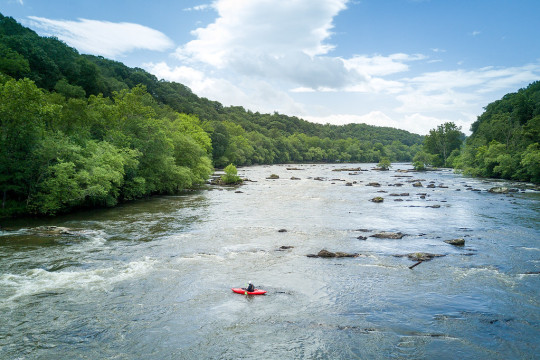
The French Broad River
French Broad River
The French Broad River winds its way past Asheville, providing a natural space for all kinds of outdoor activities & adventures.
You have your obvious river sports like whitewater kayaking and inner-tube floating, but there are some lesser-known activities here too, like “bellyaking” and whitewater SUP.
Bellyaking was actually invented in Asheville — it’s a face first kayak-type ride using special “paddle gloves” to maneuver through the rapids.
I decided to try some whitewater SUP (Stand Up Paddleboarding) for the first time with Wai Mauna SUP Tours.
Stand-up paddle-boarding through class I & II river rapids on the French Broad River requires a lot of balance, it was more difficult then the lake or ocean SUP I was used to. I fell a few times, but it was still fun!

Eating Our Foraged Food at The Marketplace

Salsa’s Restaurant in Asheville
Farm To Table Dining
Asheville is home to over 250 restaurants, many serving locally produced meats and veggies while supporting North Carolina’s farmers. They’ve been doing “farm to table” long before it became a cliche.
We obviously couldn’t try every restaurant in town with just four days, but my favorite places to eat in Asheville were The Marketplace and Salsas.
French Broad Chocolates is an ice-cream lover’s dream too. The line outside is long, but there’s a reason for that.
The chocolate ice-cream floats are sooooo good! It was worth the wait.

The Famous Biltmore Estate
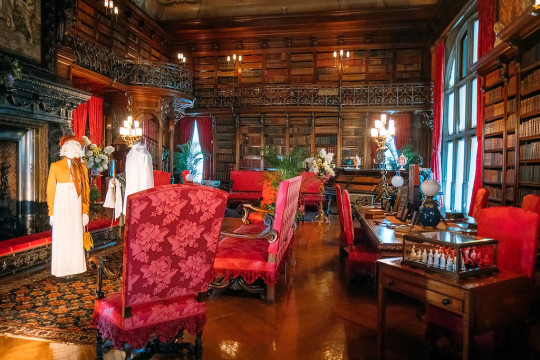
George Vanderbilt’s Extensive Library
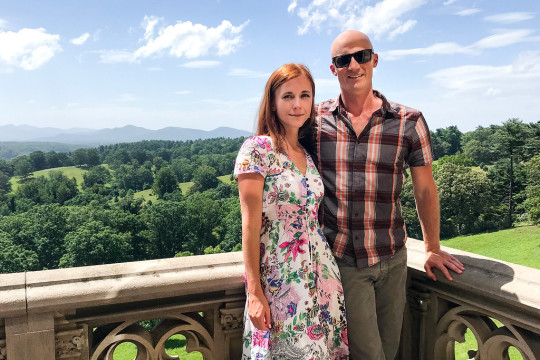
View Off the Back Deck
The Biltmore Estate
The historic Biltmore Estate is one of the most frequently suggested places to visit in Asheville. George Vanderbilt’s gigantic, hundred-year-old property is indeed quite busy all year long.
George, an heir to the Vanderbilt railroad fortune, fell in love with North Carolina and began building his property by late 1889. He decided to create a dream home surrounded by natural forests and productive farms.
This 178,926 square foot mansion sits on 8000 acres, with over 250 rooms, and is America’s largest home. The Biltmore holds regular exhibitions — they were displaying movie costumes used in films set during the XVIIIth century when we were there.
George Vanderbilt was one of the most-read men in America, and amassed a library of more than 22,000 books — including over 3,000 he read himself. Gazing at the walls of books in his preserved library was fascinating.

Wild Foraging with No Taste Like Home

Picking Chanterelle Mushrooms
Wild Foraging Tours
I’ve never been wild mushroom picking before, so we signed up for morning foraging tour with a company called No Taste Like Home.
Our day began with an overview from owner Alan Muskat about types of edibles we’d be looking for, and which poisonous plants to avoid.
After being equipped with baskets, harvesting knives, and paper bags, we headed into the enchanting North Carolina forest. I was completely surprised at how many things you could eat, and how good they tasted!
We collected Day Lily flowers, Chanterelle mushrooms, Stinging Nettle, Sassafras leaves, and strange mushrooms called Hairy Rubber Cups. While not popular in the US, they are apparently a delicacy in Malaysia.
After, you can bring your “catch” to local restaurants in Asheville like The Marketplace, where chefs prepare your dinner using the wild ingredients.

The Blue Ride Parkway

Many Fun Hikes in the Mountains
The Blue Ridge Parkway
Nestled between the Great Smoky Mountains and the Blue Ridge Mountains, Asheville offers year-round access to hiking trails and exhilarating views along the famous Blue Ridge Parkway.
The complete route stretches 469 miles from North Carolina to Virginia, and is home to a wide range of diverse plants and animals. It’s technically part of the National Park System.
Along with hundreds of hiking trails, the parkway includes sections of the Appalachian Trail — one of America’s classic long distance hikes that stretches from Georgia to Maine.
Asheville was a perfect base for exploring the Blue Ridge Parkway, and we spent a full day cruising its winding pavement. Stopping occasionally at mountain lookouts and for short hikes to admire the area’s nature.

Looking Glass Falls

Sliding Rock Falls

Natural Waterslide!
Pisgah National Forest
Pisgah National Forest is located South West of Asheville, only 30-45 minutes away. It’s considered the birthplace of modern forestry in America, and home to the country’s first forestry school.
Driving through Pisgah on Route 276 is a fun little road trip complete with waterfalls, white water rapids, hiking trails, and camping opportunities.
We stopped by two different waterfalls. The first is called Looking Glass Falls. Located right off the side of the road, it’s super easy to reach, and a nice place to cool off in the summer heat.
The second is Sliding Rock — basically a huge natural waterslide made of smooth stone. A quick ride down the 60-foot flat, sloping boulder will definitely wake you up due to the chilly 50 degree water!
The Davidson River is a popular area for fly-fishing too.

Grove Park Inn

Abbington Green B&B
Places To Stay In Asheville
If you’re wondering where to stay in Asheville, here are my recommendations:
Grove Park Inn – Asheville’s most famous hotel is one of a kind. Built out of stone on the top of a hill, it features various restaurants, a beautiful spa, and scenic views of the city.
Abbington Green B&B – This has to be one of the best bed & breakfasts I’ve ever stayed at. Beautifully designed with a peaceful garden, tasty breakfast, and friendly southern hospitality.

Downtown Asheville
Asheville Travel Tips & Advice
There’s a fun public drum circle every Friday night between 6pm – 10pm in Pritchard Park, where people of all ages join in to dance to the music.
Asheville has a beautiful array of wildflowers that bloom between April and June. Keep your eye out for trillium, lady slippers, wild ginger, evening primrose, mountain laurel, rhododendron, and many more.
The best time to visit Asheville is during the fall foliage season (October), as trees & mountains are incredibly colorful. Summers are usually pretty busy too, and get the best weather.
Parts of the Appalachian Trail pass through this region. For a taste of this famous 2,180 mile trek, try hiking the Max Patch Mountain trail for great views.
The Biltmore Estate is Asheville’s most popular attraction, so it can get quite crowded. Go super early for awesome photos and less people.
Asheville has a little something for everyone. You can enjoy scenic mountain vistas, fun live music, locally produced food and beer, a vibrant arts scene, hiking and other outdoor adventure activities too.
I have to say it has become one of my new favorite mountain towns in the United States, and an excellent weekend vacation destination. Who knows, you may never want to leave! ★
Bonus Video! Things To Do In Asheville
youtube
Subscribe to my YouTube Channel for new Adventure Travel Videos!
(Click to watch Things To Do In Asheville – North Carolina on YouTube)
More Information
Location: Asheville, North Carolina
Plan Your Trip: Explore Asheville
Useful Notes: Asheville has it’s own regional airport that’s large enough for regular commercial flights. Some airlines that fly there include Continental, Delta, United and US Airways.
Recommended Guidebook: Asheville & Great Smokey Mountains
Suggested Reading: Only In Asheville: An Eclectic History
Pin This!


READ MORE FROM THE UNITED STATES
Hiking The Zion Narrows In Utah
Miami To Key West Road Trip
Hitchhiking Across America From Coast To Coast
Any questions about traveling to Asheville, NC? Do you have any other suggestions? Drop me a message in the comments below!

This is a post from The Expert Vagabond adventure blog.
from Tips For Traveling https://expertvagabond.com/asheville-things-to-do/
0 notes
Text
One day in Guadalajara…
We were walking by some street performers and one of them was covered up in silver paint. You know, like pretending to be a statue that doesn’t move.
He was off to the side maybe maybe 15 feet away.
We were standing there for a minute or so watching this other guy be Michael Jackson. This guy was doing a real good job and had his whole dance in sync to “Thriller” which was playing on a speaker.
Then all of a sudden the silver paint statue guy blurts out “Jackie Chan!”
Obviously, he was talking to us. And we knew he was trying to get our attention, but we didn’t know what he was really trying to say. So we just laughed. (I don’t think I look like Jackie Chan.)
But I get those shoutouts every now and then when traveling.
Random people will say “Ja-pan” or “konnichiwa” when they get it right. Sometimes, they say something different.
I know they’re just trying to be friendly. But I don’t go around saying “Mexico!” or “Hola!” to random people on the street. Do you?
Maybe it’s a cultural thing. I think next time it happens, I’ll need to ask, why they say that.😆 The reality of travel.
(adsbygoogle = window.adsbygoogle || []).push({});
So why Guadalajara?
This city was never on my radar, but having been to Mexico City so many times, I was ready to explore another big city.
According to Alaska Airlines, it’s one of the art capitals of Mexico. (Their advertising is probably how I got a glimpse into what the city has to offer. They fly direct from LAX.)
Though we didn’t get to see much gallery art, there was plenty of street art.
Our first glimpse of this was driving in from the airport.
When going through the hills into the city, there were several neighborhoods of single story houses with various colorful birds painted on the sides of the houses.
Usually one large bird per house. It added a lot of color and beauty to an otherwise, unremarkable brown and dry looking landscape. Look out for them if you ever end up visiting!
Another draw for me was the regional food.
Jalisco and Guadalajara have many of their own regional specialties.
After reading about them, I knew I’d eventually make there one day. Well, that day came and went quite quickly!
We spent 2 full days there and I think it was just enough for a good tease.
Famous Foods of Guadalajara
Our first meal in the city was birria. We got take out at Birriería las 9 Esquinas for breakfast on the way to the hotel.
It was quite heavy given that we had it for breakfast and it was mostly meat.
I’d describe it as spicy, rich, savory, and very meaty.
We ate it with tortillas and onions and additional hot sauce. It reminded me of pozole, but without the hominy. Yum!
After breakfast, we needed to go for a walk. So we set out to explore.😎
Our first stop was the main square. (Where else do you go ?!)
In the square they had a large Guadalajara art installation.
There was a pretty big line the entire time that we were there to get a picture with it.
We waited about 7 minutes to get ours. Not bad!
Throughout the square they also had a bunch of cartoon characters and mascots walking around posing for pictures for people too.
After hitting up the main square, we wandered down one of the Paseo Hospicio (one of the main streets) toward the Instituto Cultural Cabañas.
Once we made it there, we split a horchata since it was pretty warm out. Horchata is always so good in Mexico!!
On the way back, we saw some little electric cars being driven around by kids who looked liked they were having fun.
When I was a kid, those cars were one thing that I always wanted to drive. None of my friends had one, so I never got to drive one.
So I guess I have to just live vicariously through those little kids.
After thoroughly exploring the historical center, we ended up making a small trek to get tamales at Ricos Tamales for a late lunch.
We shared a red mole with pork tamale and a vegetable tamale as well as a vanilla atole drink.
While we were eating, a lot of local people stopped by to get take out.
This place was worth the trek as it was all very good!
For dinner, we had a reservation at Lula Bistro. It was my second choice for a nice meal, but the other restaurant Allium was MIA (according to their Facebook, they were out on holiday).
I’ll be sharing the Lula Bistro experience in a separate post tomorrow. It was definitely one of the highlights of our trip, food wise!
Guadalajara Day 2: More Food
The next day we got chilaquiles for breakfast from La Chata.
This restaurant seemed to be pretty popular with the locals also. The chilaquiles were good, but to be honest, it’s not one of my favorites.
After breakfast we went to some of the produce markets since I wanted to get some beans and peppers to take home.
I got a pretty good amount (1 kg chiles -ancho, pasilla, mulato, guajillo + 1kg beans-peruano, texano, and flor de junio).
Now I just need to figure out what to do with them!! 😃 Any suggestions??
We dropped my haul back off at the hotel before going to get lunch.
We took a long 40 minute walk to get carne en su jugo. Which is stewed beef.
It came with tortillas, chips, onions, limes, and beans. This was sooo good.
I need to find a recipe and try to recreate this at home. 🍖
This dish alone totally made the trip worth it!!😋
There are two restaurants that seemed like the ‘go-to’ for this particular dish. We chose Kamilos 333 since it seemed less touristy and had better reviews.
It’s right next door is it’s competitor Karne Garibaldi, which has a Guinness world record of serving the fastest meal or something like that.
Kamilos was a good choice since the food was bomb. And, while we were their the clientele seemed to be local families and business people. Always a good sign, in my opinion!
After this, we did some more walking around at one of the local parks. We thought we knew where to enter but the entrance we tried to go to was closed.
We ended up walking around the entire perimeter of the park and ending up almost where we started before we were able to go in.
What kind of public park has one way in and one way out?! 😒 Parque Agua Azul !!
Since it was a weekend, they had a flea market nearby. It was mostly clothes and gothic apparel with the corresponding gothic looking crowd. Never expected to see that kind of a scene in Mexico, but there it was!
Just a block away, they had a completely different crowd. There was some sort of Hot Wheel convention going on. It looked like people where buying or trading cars. Yes, the little toy Hot Wheels! Totally different vibe!
After this, we headed back to get our bags as it was already time to go to the airport!
In summary, I really liked Guadalajara. It didn’t have as many tourists as Mexico City.
It also felt a lot more Mexican and much more relaxed.
One thing I noticed about Guadalajara, is that the buildings are not tall. At most, those located downtown seemed only a few stories high. I think it seems to add a bit a of space or calm to the atmosphere.
If you ever get a chance, I would definitely consider visiting Guadalajara.
For me the food was my favorite part. I’m happy that I had the opportunity to try some of the regional specialties Guadalajara is known for.
I enjoyed seeing the new sights, sounds and smells. It was very stimulating and eye-opening. In a good way.
The real Mexico that you don’t hear about everyday.
#gallery-0-4 { margin: auto; } #gallery-0-4 .gallery-item { float: left; margin-top: 10px; text-align: center; width: 33%; } #gallery-0-4 img { border: 2px solid #cfcfcf; } #gallery-0-4 .gallery-caption { margin-left: 0; } /* see gallery_shortcode() in wp-includes/media.php */
birria
guava and strawberry
city sign in the center square
line for the sign
cathedral
electric cars
long fountain
horchata
art
monument
near the center of the city
city info
art
characters
one of the markets
Ricos Tamales
tamales!!
the theatre
cathedral at dusk
chilaquiles
art in the works
art
art
another square
the place to get carne en su jugo
carne en su jugo
hot wheel convention
coconut + hochata
look at all that candy!
one of the shops i bought my goods at
airport
1 kg chiles (ancho, pasilla, mulato, guajillo) + 1kg beans!(peruano, texano, and flor de junio)
If you haven’t already, you can also read my previous trip reports to Mexico below
Mexico Trip December 2016: Part 5 Mexico City Can’t Get Enough!
Mexico Trip December 2016: Part 4 Mexico City Discoveries
Mexico Trip December 2016: Part 3 Mexico City Never Gets Old
Mexico Trip December 2016: Part 2 Puebla
Mexico Trip December 2016: Part 1 Mexico City
Cozumel, Tulum, Playa del Carmen, BPM Festival Mexico 2016
Merida, Yucatan and Mexico City November 2015 Trip Report
If you liked what you saw, please join my email list! No more than once a week, I send out weekly finds (including travel tips) and site updates!
Email list sign up bonus: A free copy of my Ebook All Day I Eat’s Top 10 Recipes for 2016!
[mc4wp_form id=”1849″]
Mexico Trip December 2016: Part 6 Guadalajara One day in Guadalajara... We were walking by some street performers and one of them was covered up in silver paint.
0 notes
Text
‘La Brutta Figura’ was partly inspired by the desire to communicate to others the gulf of difference between visiting a country, namely Italy, and living there. Italy might be another European country but it’s arbitrary fashion rules, imperative food traditions and relaxed employment regulations could hark from Mars from the expat’s point of view. My first ever blog post explored the concept of ‘la brutta figura’ – making a bad impression – which ranges from the wrong use of the informal ‘you’ to wearing unbranded sunglasses to not being able to wax lyrical about a Raffaello painting on command. ‘La bella figura’ is an art, encompassing appearance, comportment, cultural education and more besides.
After two years of living in Italy, however, I still have never been able to beat an Italian at paying for a drink at the bar, still do not have a specific ‘intimo’ soap solely for the bidet and still have never been able to swirl a glass of wine without narrowly avoiding a burgundy disaster. While the bella figura does relate to appearance, that side is certainly the most superficial element. The bella figura really shines through with how you conduct yourself in social situations and your educated conversation. I have therefore decided that through the aid of some very Italian New Year’s Resolutions I shall transform the brutta figura into the bella figura and share with you the essentials for becoming a full fledged italiana!*
*Well, a few New Year’s Resolutions aren’t going to prevent an expat sticking out like a sore thumb in a social situation but it will at least be an improvement on my first few months here naively saying ‘ciao’ to all the anziani… (very impolite).
1.Learn to make fresh pasta (properly) from Nonna from the South
Every morning my boyfriend’s grandmother, who comes from Basilicata in the south, makes fresh pasta using flour she brought from her home because she doesn’t trust the produce in the north. She makes anything from tagliatelle to tortellini and she tells me it’s very theraputic. It may be a little antiquated but it certainly should be a skill in la bella figura’s repetoire.
2.Undergo a cooking course in a Tuscan villa so I can whip up a delicious three course dinner at a moment’s notice
Wood, market, kitchen. Autumn comes along with a roasted turkey. Autumn has arrived into the forest, you could notice it looking at the road that passes through it. It is now ploughed by wide puddles that reflect the sky and its moods. The leaves muffle your steps, the bushes are coloured by rose hips and juniper. A new recipe up on the blog (link in bio)
A photo posted by Giulia Scarpaleggia (@julskitchen) on Nov 8, 2016 at 9:19am PST
A born and bred Tuscan Giulia Scarpaleggia teaches from her traditional family home in the countryside making dishes based on local ingredients (such as pecorino cheese or olive oil from local producers) and seasonal varieties. Every town and village in Italy seems to have its local speciality born from the particularities of produce and agriculture characteristic of that area. It’s time to impress with my profound knowledge of Italian culinary variety and superior cooking skills, and a cooking course involving wine and dinner after seems to be a good start. (website here)
3.Avoid Food Crimes
We expats always get snide remarks about drinking the wrong coffee at the wrong time of day or the absurd concoction that is Hawaiian pizza or our complete ignorance towards good food in general. Eating and drinking is a minefield and the expat needs to be battle ready to avoid shameful faux pas. Helpfully, the Academia Barilla lists the 10 Italian Cooking Commandments on their website using many angry exclamation marks. Take note expats.
4.Become a wine snob
Rule 1. Don’t sit on the ground
Traditional Venetian bacaro
The unfortunate dislexic Vicar of Nibbleswicke taught flummoxed readers that one should never ‘plug’ wine, but rather ‘pis’ it, but that’s about as far as my wine knowledge goes. Unfortunately that won’t cut it in Italy. You need to know your millesimato from your *insert Italian wine beginning with ‘m’ here. And knowing that white wine goes well with fish is not impressive. I have a lot to learn, and hoping this knowledgeable fellow’s blog (web address ‘ubriaco’) and this jazzy blog, which is certainly not written by ‘balding upper-middle-class twits’, will assist me.
Here, incidently, are more rather terrifying commandments this time on the subject of wine, enlivened with words like ‘adulteration’, ‘covet’ and ‘murder’. They are, however, riddled with wine in-jokes which are lost on me.
5.Learn the formal ‘you’
My couple of years learning Italian at school have been invaluable here, but one yawning gap in my knowledge is using formal address. At school you do not learn a language with the sole aim of living in the country in the future, and in fact the language you use as an expat is vastly different. I might have come from school knowing how to analyse the metaphors in a novel but I spent months praying I’d never need to ask for a knife and fork in a restaurant. The formal ‘you’ is certainly something that never seemed vital at school but one wrong verb ending and I’ve unintentionally offended a harmless old man. It’s time to buy a grammar textbook and get learning the eternal variations of verb endings that exist in Italian! I recommend the Palgrave Foundations series for any budding Italian students.
6.Express yourself in style
Italian is the language of poetry, of epic texts, of oratory and eloquence. It is full of heavenly musical sounds (which makes it so well suited to opera). It is also a very creative language, with innumerable delightful idioms and expressions to enliven dialogue. People who are able to exploit the great variety of Italian to its fullest extent are rare and are respected. Grammar can get tedious so I’ll supplement it with improving my knowledge of unusual adjectives and quirky idioms. Here are some expressions to get started, on the topic of food:
You are like parsley – you pop up everywhere.
I know my chickens – I know who I’m talking about.
You can’t have a full barrel and a drunk wife – you can’t have your cake and eat it.
Don’t be a salame – don’t be an idiot.
7.Travel to Learn and Learn to Travel
Vipiteno on the border
One of the most valuable gains from living (rather than just visiting) Italy is the luxury to do day trips or weekends in the car to little villages or country villas or lonely monasteries that those tourists arriving by plane tend to miss. From these visits one realises the real depth and breath of culture that derives partly from the fact that Italy only became a unified country in 1871. As such even the most insignificant town has its speciality dishes, its own celebrations and customs, its own traditional dress and often its own language (there are hundreds of different languages and dialects spoken throughout The Boot deriving from Latin, Romance, Germanic, Slavic and Hellenic roots). Cultural knowledge is of great standing when it comes to la bella figura so my future travels around the bel paese will have a new role as opportunities to deepen my knowledge of my adopted home.
8.Celebrate Traditional Festivals
The still very individual regions of Italy express their characters through local festivals deriving from celebrations of food, drink, religion, politics and more. While sadly the cynical modern world means folk dancing and wood whittling are becoming less popular past-times, these festivals are still celebrated profusely with local customs. In the tourist-ridden cities the revival some of these festivals may be the cunning plan of the tourist board, but venture into smaller cities or the countryside and you can find, for example, the festival of the jujube berry in Arquà Petrarca (the berry liqour is very tasty), or chestnut festivals throughout autumn, or the lesser-known but very entertaining Palio of Ferrara (involving donkeys). The Italian has Italy in his heart, there’s no doubt about that, but his greatest love is for his region and his town.
I think that’s ambitious enough to be getting on with. Look out for a similar post next Capodanno as it’s likely I’ll have spent the year drinking wine using the ‘plug’* method and thinking lasagne is the height of culinary achievement rather than attempting these New Year’s Resolutions.
*For those of you whose childhood did not revolve around Roald Dahl books and dreaming of going poaching with Danny and his Dad, this means ‘gulp’.
Buon Anno!
The Elusive Bella Figura and How to Find It 'La Brutta Figura' was partly inspired by the desire to communicate to others the gulf of difference between visiting a country, namely Italy, and living there…
#Capodanno#chestnuts#Italian cooking#Italian specialities#language#New Year#pasta#resolutions#Travel#wine
0 notes